practice Exercise 7.1 from GK PUBLICATIONS PHYSICS (HINGLISH) FLUID MECHANICS for Class 11
| Class 11 | PHYSICS |
| Chapter | FLUID MECHANICS |
| GK PUBLICATIONS PHYSICS (HINGLISH) | practice Exercise 7.1 |
| Medium | English |
| Academic Year | 2023-2024 |
Question 3
A vessel full of water has a bottom of area 20cm2, top of area 20cm2, height 20 cm and volume half a litre as shown in figure.
(a) find the force exerted by the water on the bottom.
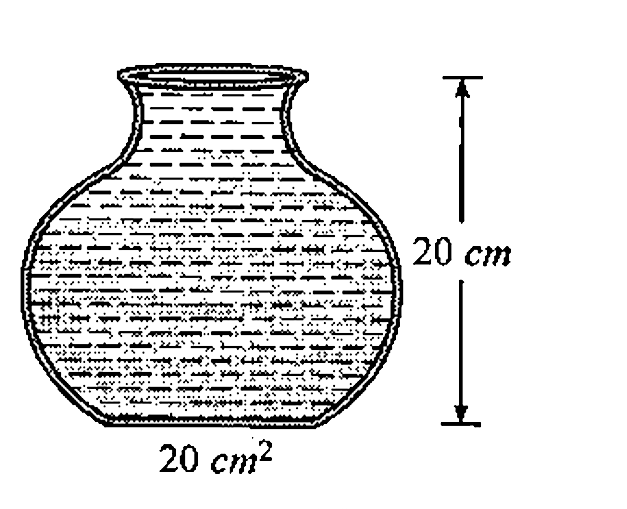
(b) considering the equilibrium of the water, find the resultant force exerted by the sides of the glass vessel on the water. atmospheric pressure =1.0×105N/m2. density of water =1000kg/m3 and g=10m/s2 View SolutionQuestion 4
A hollow sphere of innder radius 9 cm and outer radius 10 cm floats half-submerged in a liquid of specific gravity 0.8. calculate the density of the material of which the sphere is made. What would be the density of a liquid in which the hollow sphere would just floats completely sumberged. ?View SolutionQuestion 7
A flat bottomed thin-walled glass tube has a diameter of 4 cm and it weights 30 g. the centre of gravity of the empty tube is 10 cm above the bottom, find the amount of water which must be poured into the tube so that when it is floating vertically in a tank of water, the centre of gravity of the tube and its contents is at the midpoint ot the immersed length of the tube. View SolutionQuestion 8
A uniform rod AB, 4m long and weighing 12 kg, is supported at end A, with a 6 kg lead weight at B. The rod floats as shown in figure with one-half of its length submerged. The buoyant force on the lead mass is negligible as it is of negligible volume. Find the tension in the cord and the total volume of the rod
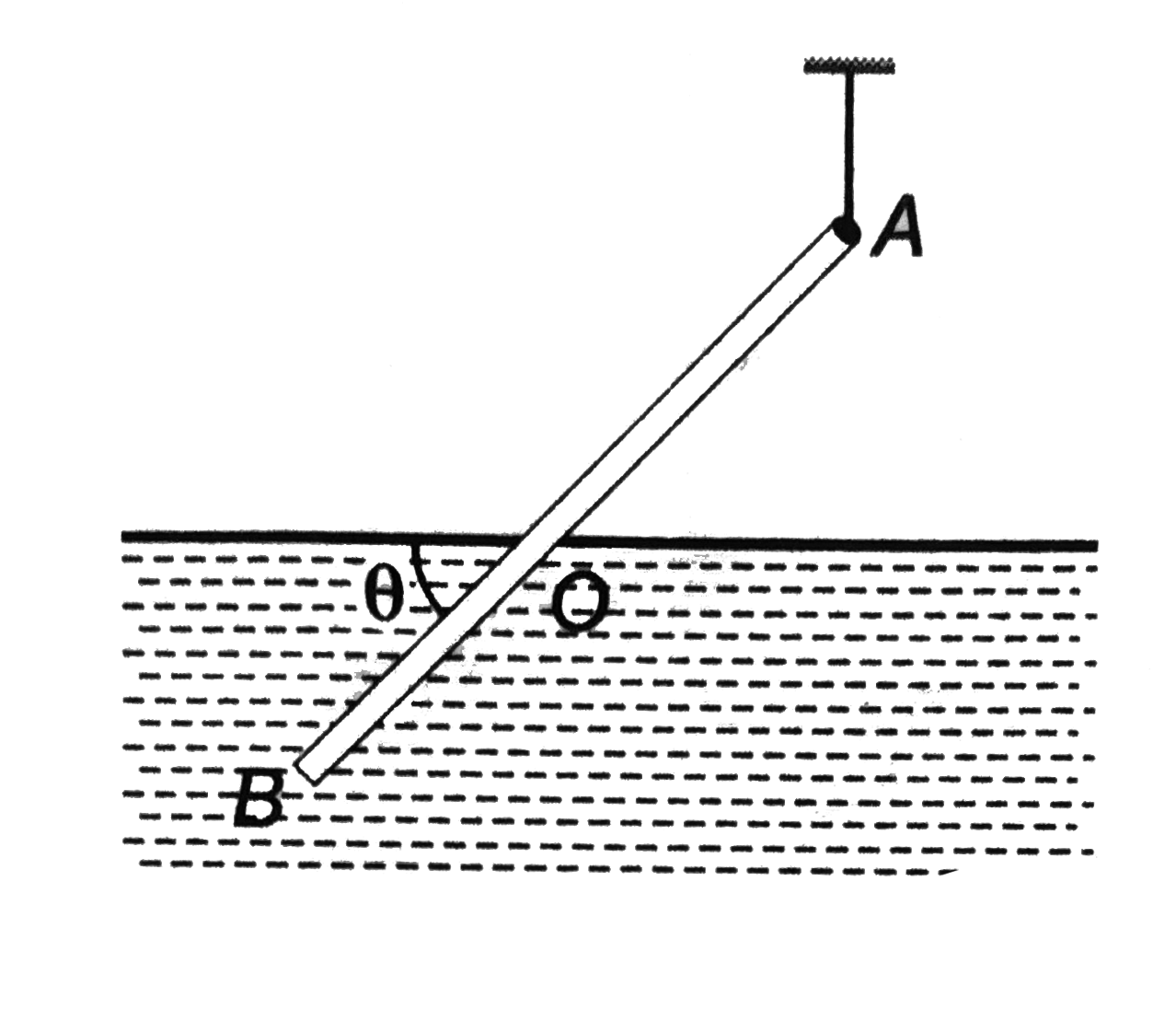 View Solution
View SolutionQuestion 9
Water stands at a depth h behind the vertical face of a dam. It exerts a resultant horizontal force on the dam tendibg to slide it along its foundation and a torque tending to overturn the dam about the point O. Find
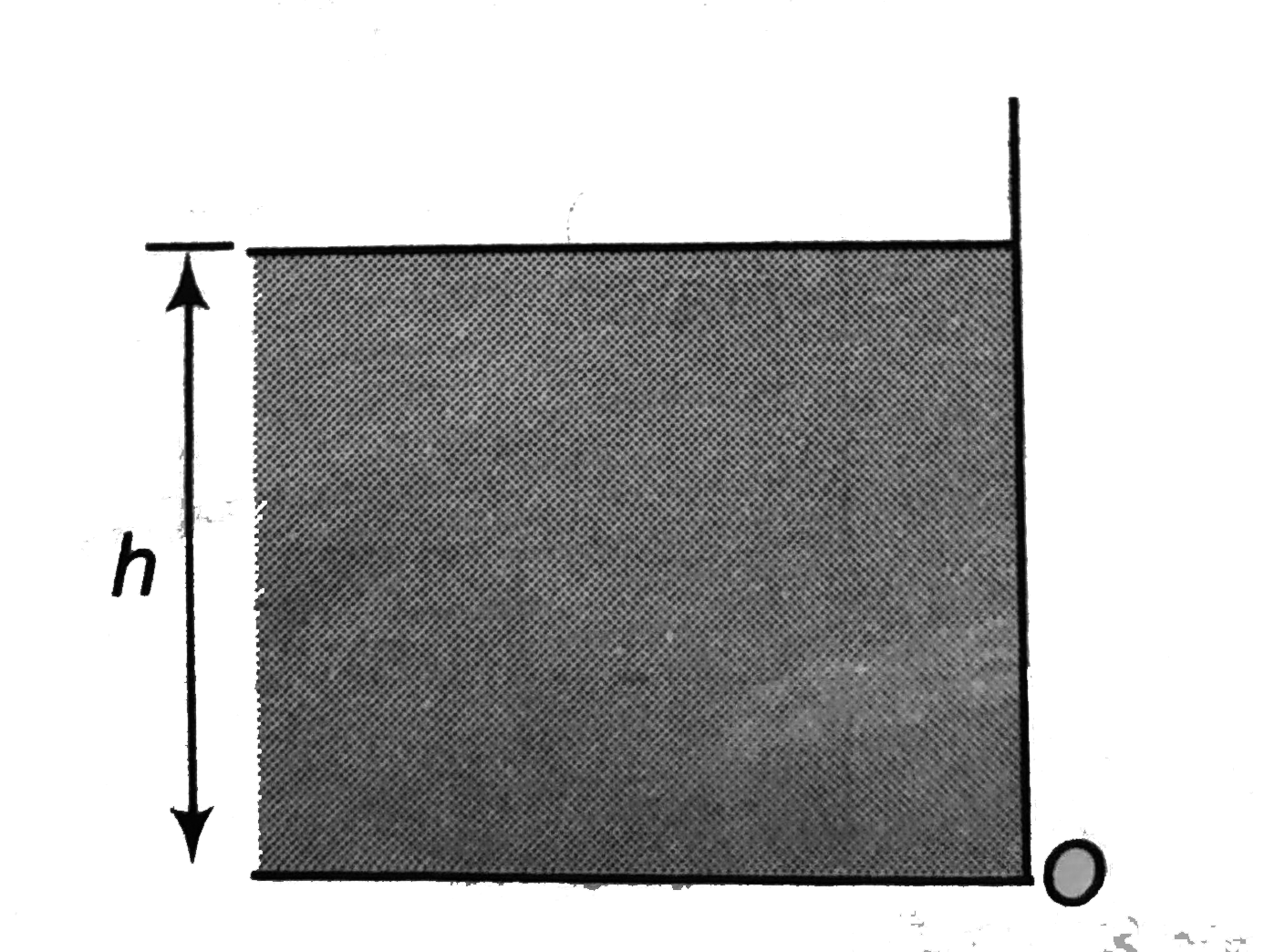
(a) Horizontal force,(b) torque about O, (c ) the height at which the resultant force would have to act to produce the same torque,l=cross-sectional length and ρ=density of water.View SolutionQuestion 11
A rubber ball of mass 10 gram and volume 15cm3 is dipped in water to a depth of 10m. Assuming density of water uniform throughtout the depth, find (a) the ac celeration of the ball, and (b) the time taken by it to reach the surface if it is relased from rest. (Takeg=980cm/s2)View SolutionQuestion 13
A solid sphere of mass m=2kg and specific gravity s=0.5 is held stationary relative to a tank filled with water. The tank is accelerating upward with acceleration 2m/s2. Calculate
(a) Tension in the thread connected between the sphere and the bottom of the tank.
(b) If the thread snaps, calculate the acceleration of sphere with respect to the tank.
(Density of water =1000kgm−3,g=10ms−2).
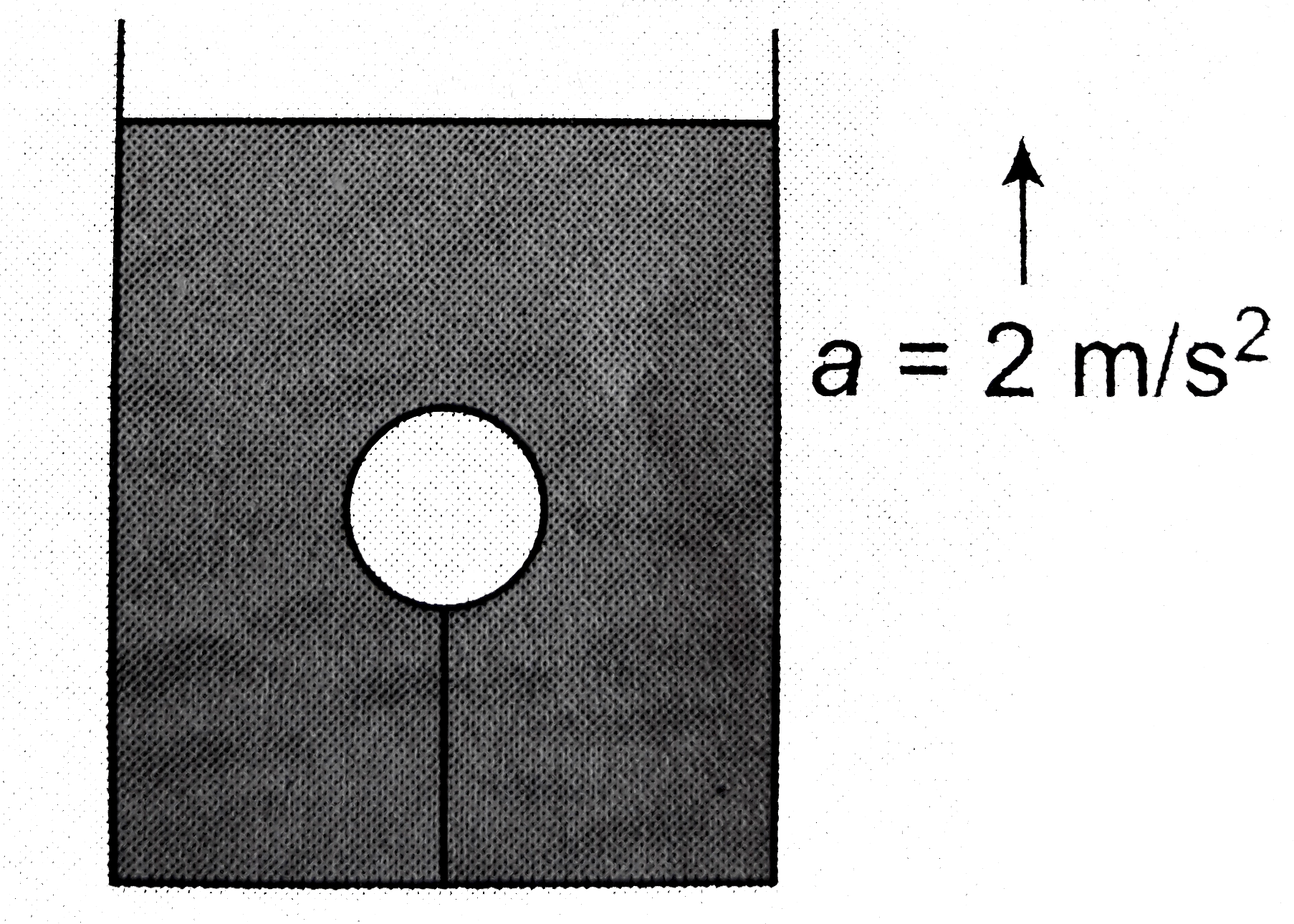 .View Solution
.View SolutionQuestion 18
For the system shown in figure, the cylinder on the left, at L, has a mass of 600 kg and a cross-sectional area of 800cm2. The piston on the right, at S, has cross-sectional area 25cm2 and negligible weight. If the apparatus is filled with oil (ρ=0.78g/cm3), what is the force F required to hold the system is equilibrium?
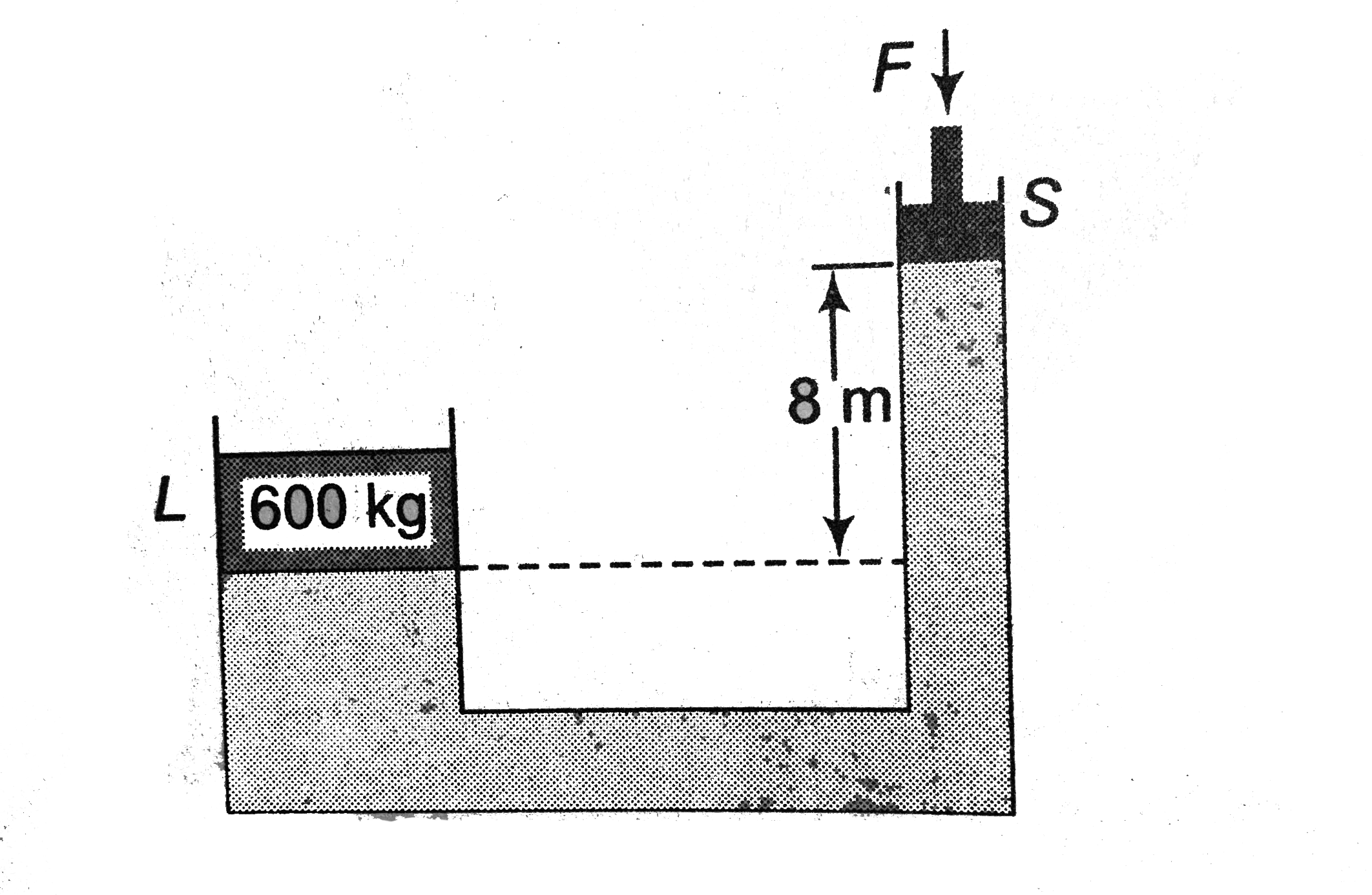 .View Solution
.View SolutionQuestion 19
At Deoprayag (Garhwal, UP) river Alaknanda mixes with the river Bhagirathi and becomes river Ganga. Suppose Alaknand has a width of 12 m, Bhagirathi has a width of 8m and Ganga ha sa width of 16m. Assume that the depth of water is same in the three rivers. Let the average speed of water in Alaknanda be 20kmh−1 and in Bhagirathi be 16kmh−1. Find the average speed of water in the river Ganga.View SolutionQuestion 23
A cylindrical vessel filled with water up to a height of 2m stands on a horizontal plane. The side of the vessel has a plugged circular hole so that the vessel begins to move on the floor it the plug is removed. The coefficient of friction between the bottom of the vessel and the plane is 0.4, and total mass of water plus vessel is 100kg.View SolutionQuestion 24
Water is flowing through two horizontal pipes of different diameters which are connected together. In the first pipe the speed of water 4 m/s and the pressure is 2.0×104N/m2. Calculate the speed and pressure of water in the second pipe. The diameter of the pipes the diameter of the pipes are 3 cm and 6 cm respectively. View SolutionQuestion 25
A horizontal oriented tube AB of length l rotates with a constant angular velocity ω about a stationary vertical axis OO' passing thorugh the end A figure. The tube is filled with an ideal fluid. The end A of the tube is open, the closed end B has a very small orifice. find the velocity of the fluid relative to the tube as a function of the column height h.
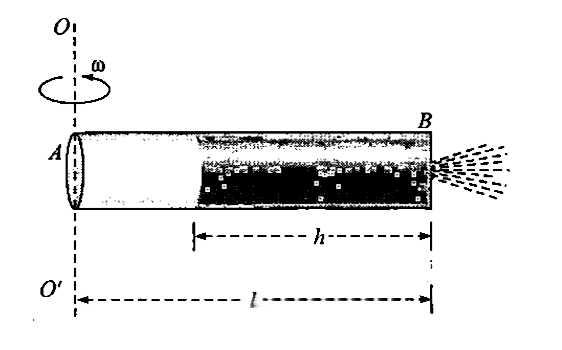 View Solution
View SolutionQuestion 27
The fresh water behind a reservoir dam is 15m deep. A horizontal pipe 4.0cm in diameter passes through the dam 6.0m below the water surface as shown in the figure. A plug secures the pipe opening :
(a) Find the friction force between the plug and the pipe wall.
(b) The plug is removed. What volume of water flows out of the pipe in 3.0 hour ? Assume that reservoir is large.
 .View Solution
.View SolutionQuestion 32
A beaker containing water is placed on the pan of a balance which shows a reading of M. A lump of sugar of mass m and volume v is now suspend by a thread (from an independent support) in such a way that it is completely immersed in water without touching the beaker and without any overflow of water. How will the reading change as time passes on?View SolutionQuestion 44
Two vessels have the same base area but differnent shapes. The first vessel takes twice the vloume of water that the second vessel requires to fill up to a paricular common height . Is the force exerted by water on the base of the vessel the same in the two case? If so, why do the vessels filled with water to that same height give different reading on a weighting scale ?View SolutionQuestion 50
A beaker containing water is placed on the pan of a balance which shows a reading of M. A lump of sugar of mass m and volume v is now suspend by a thread (from an independent support) in such a way that it is completely immersed in water without touching the beaker and without any overflow of water. How will the reading change as time passes on?View SolutionQuestion 62
A medical suspension bottle is shaken well to disperse the sediment uniformly and immediate, the bottle is placed on a digital weighing machine gently. If W be the actual combined weight of the bottle and the medicine, then the weight recorded by the weighing machine immediately after placing the bottle will be :View SolutionQuestion 64
It is found that the measured weight (≠ zero) of an empty thin polythene bag has not changed when the bag in filled with air. Two students were asked reason for this :
Saara: Air is so light that weighing machine need to have large precision to measure weight of filled air.
Vasu : Force of buoyance increases by the same amount as the weight of added air .View SolutionQuestion 69
A large open tank has two holes in the wall. One is a square hole of side L at a depth y from the top and the other is a circular hole of radius R at a depth 4y from the top. When the tank is completely filled with water, the quantities of water flowing out per second from both holes are the same. Then, R is equal to View SolutionQuestion 72
A tube in vertical plane is shown in figure. It is filled with a liquid of density ρ and its end B is closed. Then the force exerted by the fluid on the tube at end B will be : [Neglect atmospheric pressure and assume the radius of the tube to be negligible in comparison to l]
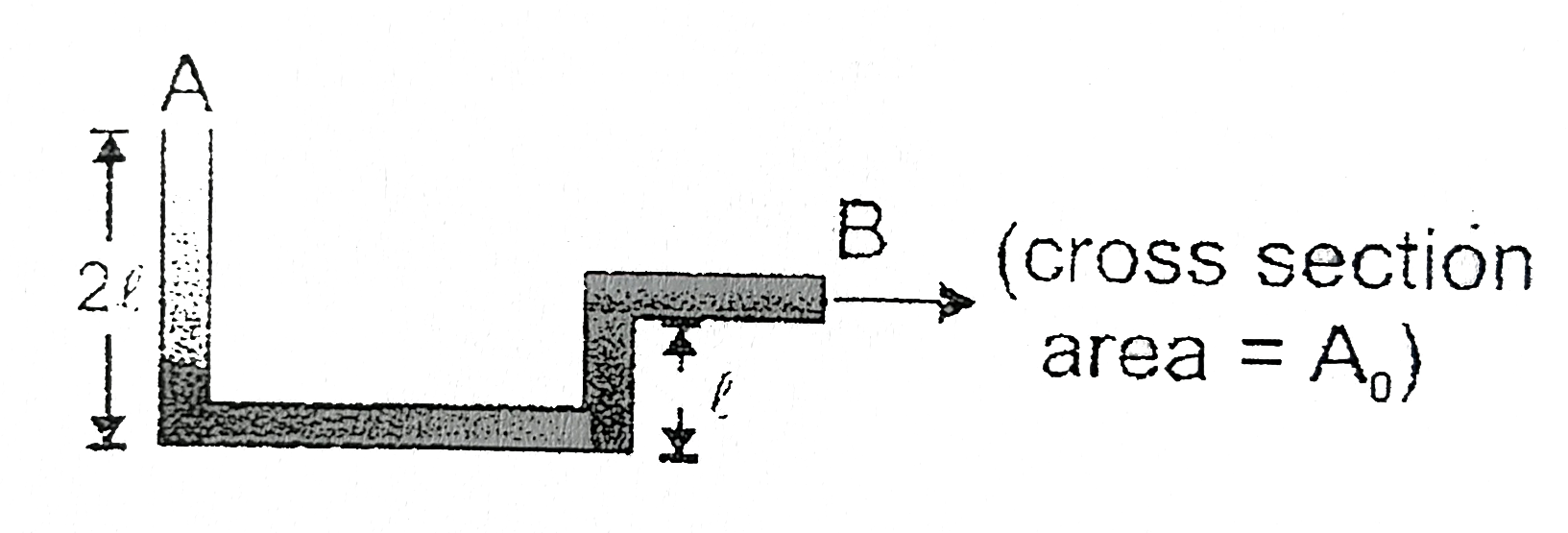 View Solution
View SolutionQuestion 73
Figure shows water filled in a symmetrical container. Four pistons of equal area A are used at the four openings to keep the water in equilibrium. Now an additional force F is applied at each piston. The increase in the pressure at the centre of the container due to this addition is
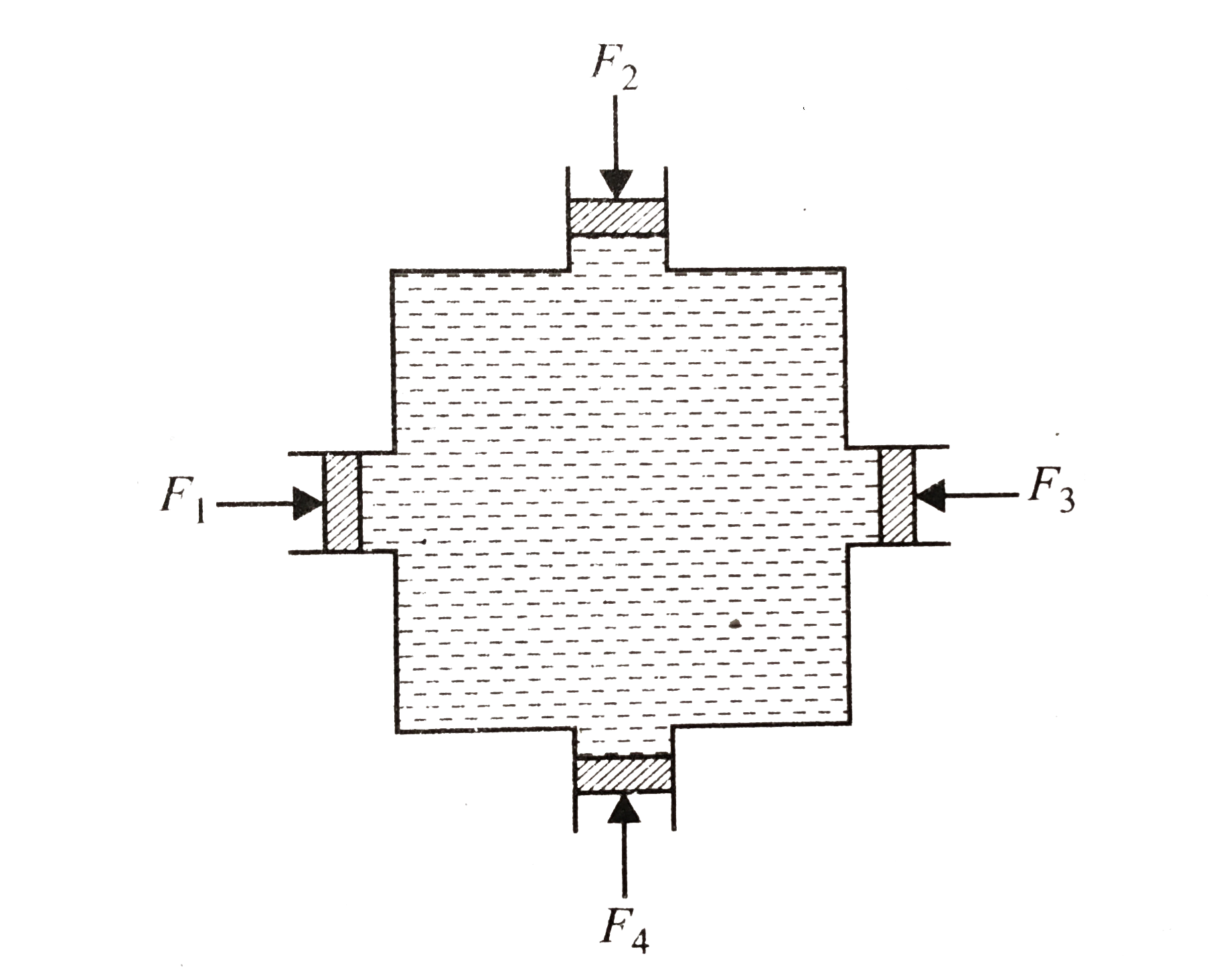 View Solution
View SolutionQuestion 77
A non uniform cylinder of mass m, length l and radius r having its C.O.M at a distance l4 from centre and lying on axis of cylinder . The cylinder is kept in a liquid of uniform density ρ. The moment of inertia of the rod about C.O.M is I. The angular acceleration of point A relative to point B just after the rod is released from position shown in figure is .
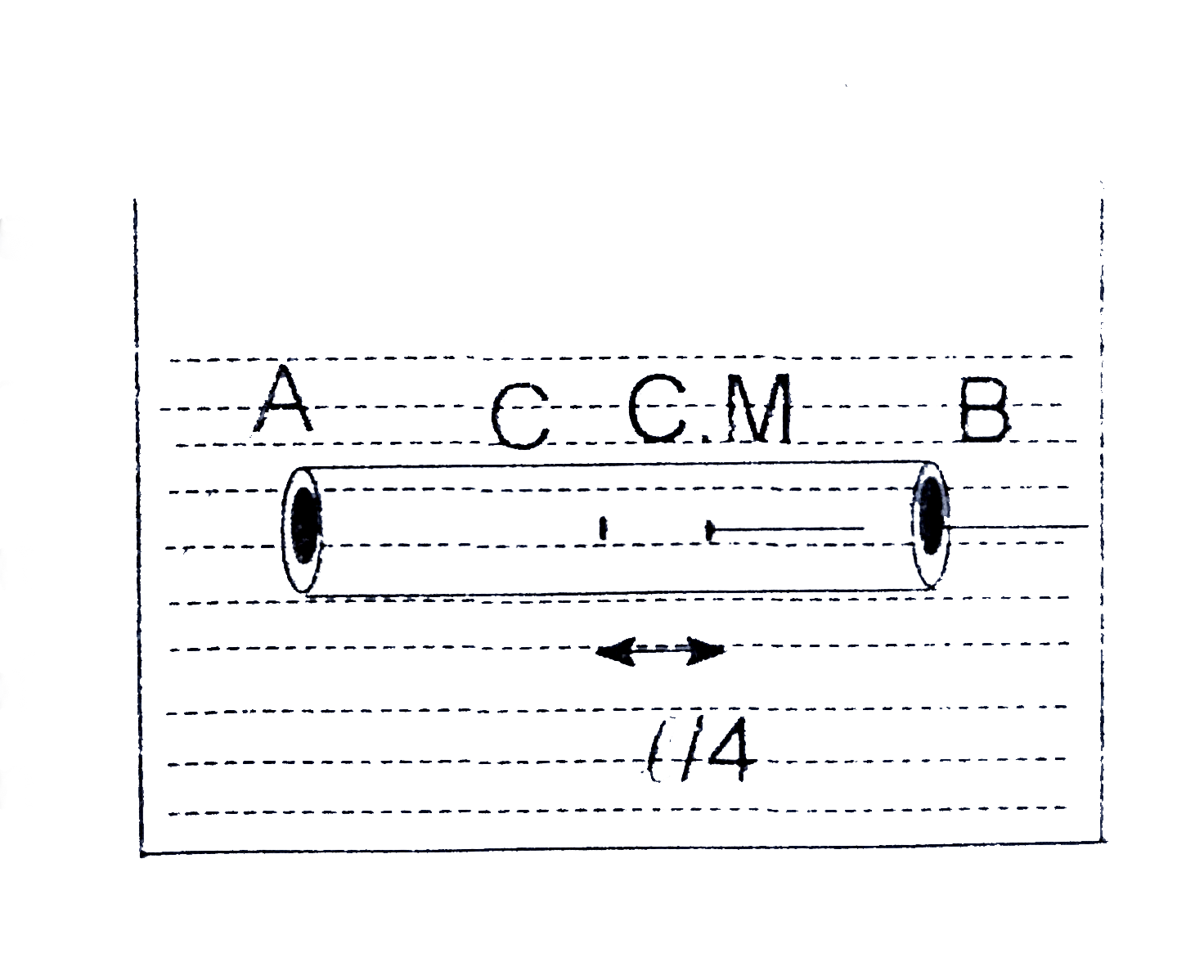 View Solution
View SolutionQuestion 81
A uniform rod OB of length 1m, cross-sectional areal 0.012m2 and relative density 2.0 is free to rotate about smooth hinge O in vertical plane. The rod is held with a horizontal string AB which can withstand a maximum tension of 45N. The rod and string system is kept in water as shown in figure. The maximum value of angle α which the rod can make with vertical without breaking the string is
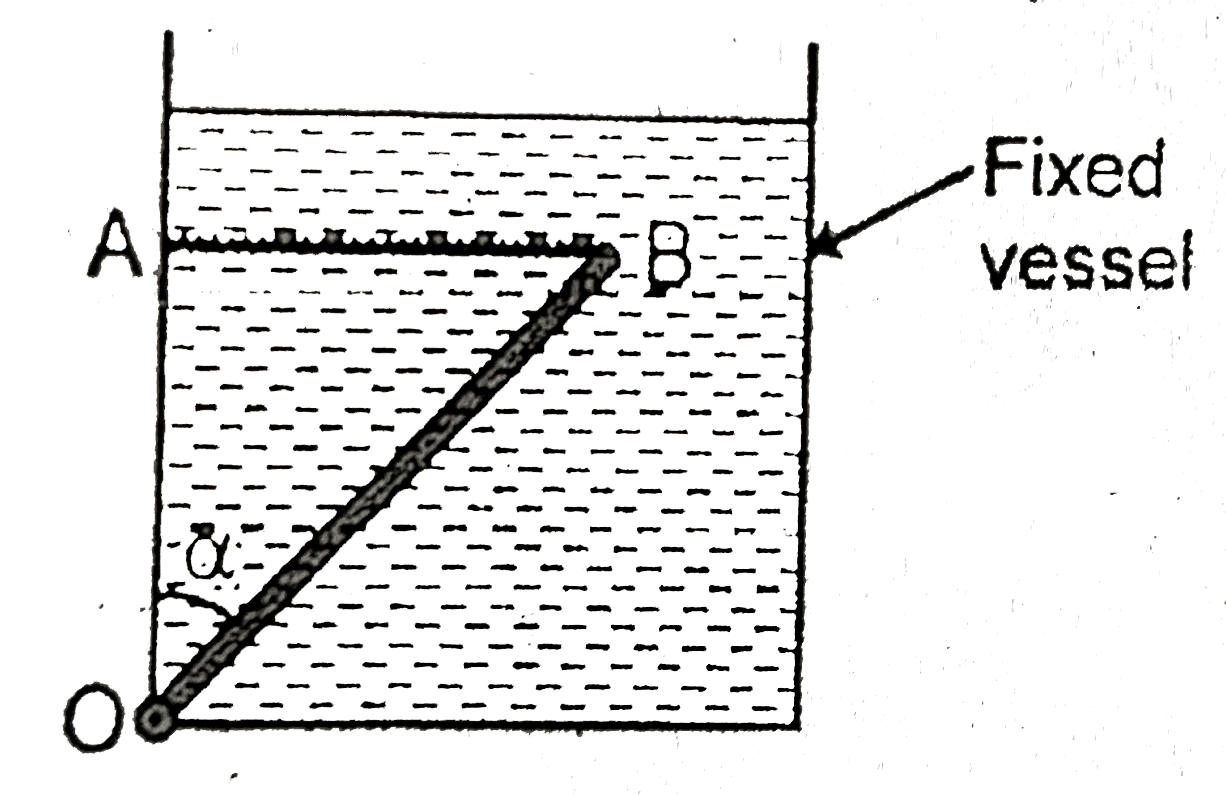 View Solution
View SolutionQuestion 82
A tube with both ends open floats vertically in water. Oil with a density 800 kg/m3 is poured into the tube. The tube is filled with oil upto the top end while in equilibrium. The portion out of the water is of length 10 cm. The length of oil in the tube is 10αcm. Find α (assume effect of surface tension is neglible):
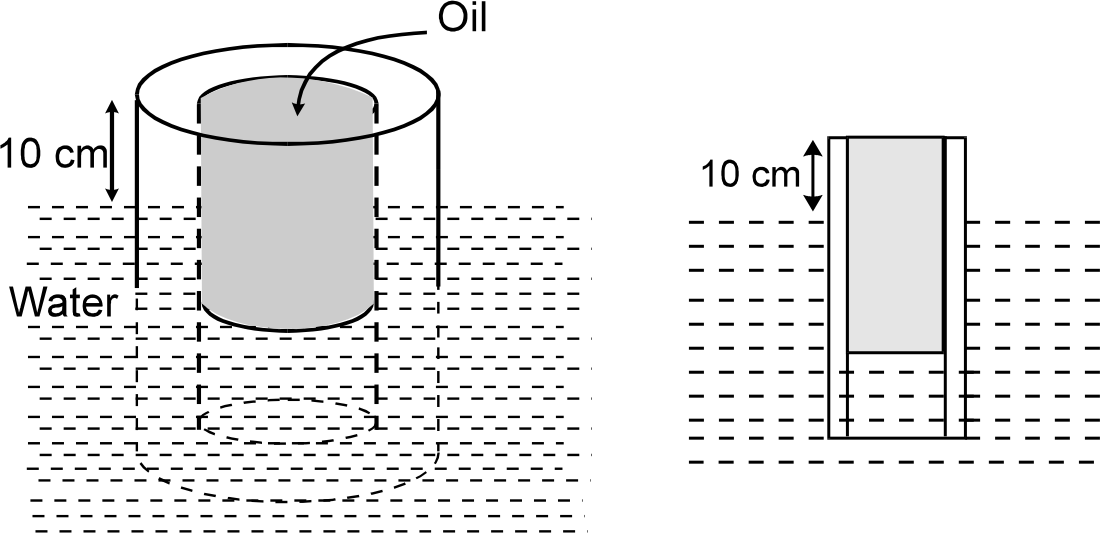 View Solution
View SolutionQuestion 83
Following are some statements about buoyant force : (Liquid is of uniform density)
(i)Buoyant force depends upon orientation of the concerned body inside the liquid.
(ii)Buoyant force depends upon the density of the body immersed.
(iii)Buoyant force depends on the fact whether the system is on moon or on the earth.
(iv)Buoyant force depends upon the depth at which the body (fully immersed in the liquid) is placed inside the liquid. Of these statements :View SolutionQuestion 84
An ideal fluid is flowing through the given tubes which is placed on a horizontal surface. If the liquid has velocities VA and VB and pressure PA and PB at point A and B respectively, then the correct relation is (A and B are at same height from ground level. the figure shown is as in the system is seen from the top):
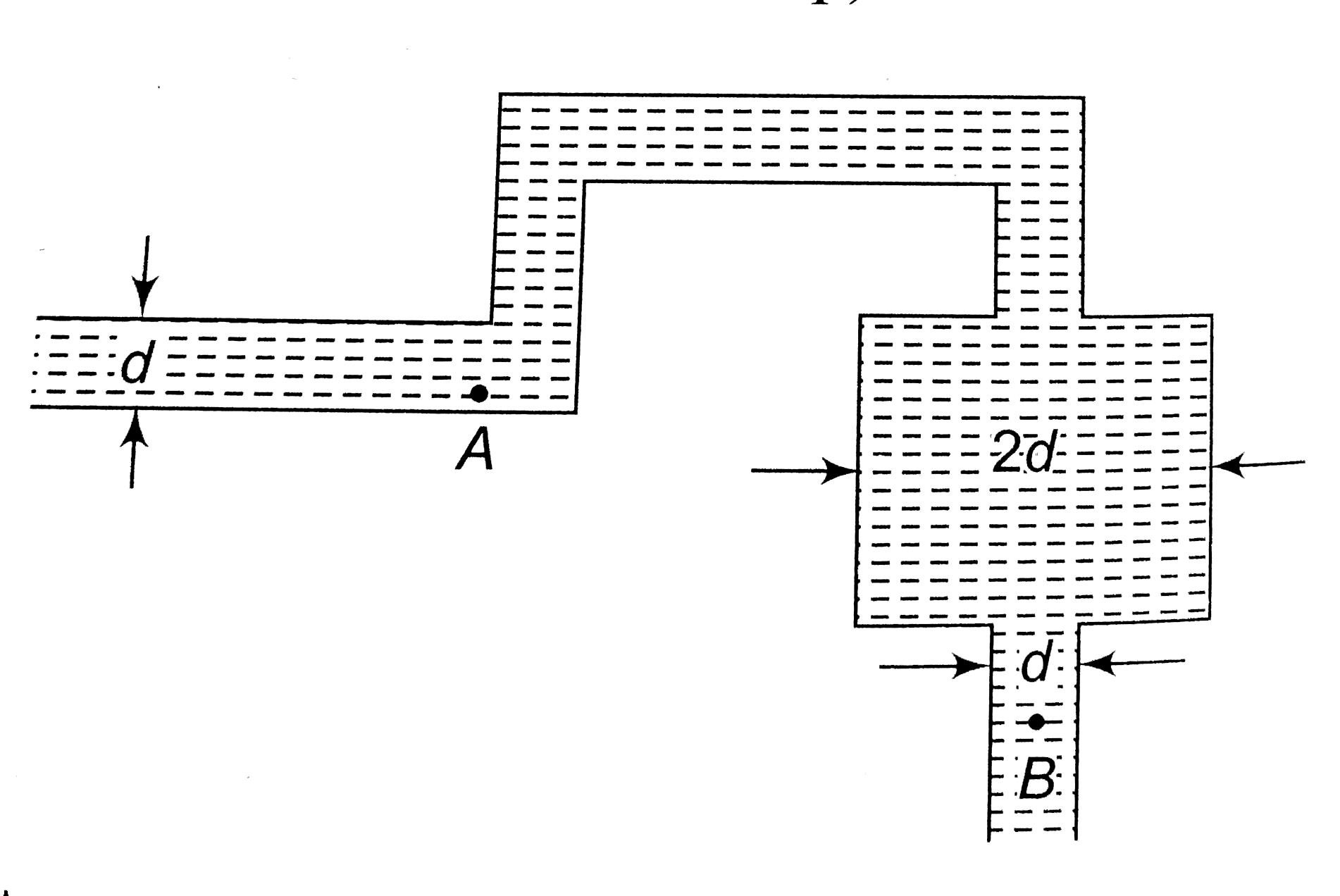 View Solution
View SolutionQuestion 86
A fixed container of height H with large cross-sectional area A is completely filled with water. Two small orifice of cross-sectional area a are made, one at the bottom and the other on the vertical side of the container at a distance H/2 from the top of the container find the time taken by the water level to reach a height of H/2 from the bottom of the container.View SolutionQuestion 89
A copper piece of mass 10 g is suspended by a vertical spring. The sprig elongates 1 cm over its natural length to keep the piece in equilibrium. A beaker containing water is now placed below the piece so as to immerse the piece completely in water. Find the elongation of the spring. Density of copper =9000 kgm^-3. Takeg=10ms−2View SolutionQuestion 92
_S01_025_Q01.png)
A cubical block of wood of edge 3 cm floats in water. The lower surface of the cube just touches the free end of a vertical spring fixed at the bottom of the pot. Find the maximum weight that can be put on the block without wetting it. Density of wood =800kg/m3 and spring constant of the spring =50N/m. Take g=10m/s2View SolutionQuestion 104
One end of a long iron chain of linear mass density λ is fixed to a sphere of mass m and specific density 1/3 while the other end is free. The sphere along with the chain is immersed in a deep lake. If specific density of iron is 7 , the height h above the bed of the lake at which the sphere will float in equilibrium is (assume that the part of the chain lying on the bottom of the lake exerts negligible force on the upper part of the the chain)
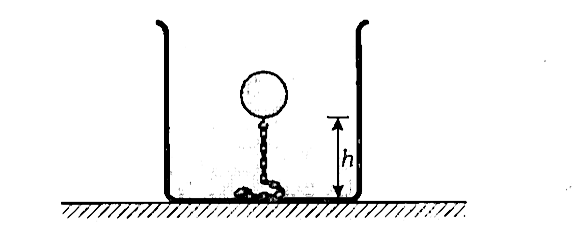 View Solution
View SolutionQuestion 106
An object is weighted at the North Pole by a beam balance and a spring balance, giving readings of WB and WS respectively. It is again weighed in the same manner at the equator, giving readings of W'B and W'S respectively. Assume that the acceleration due to gravity is the same everywhere and that the balance are quite sensitive, Choose the wrong optionView SolutionQuestion 107
A spring balance reads W1 when a ball is suspended from it. A weighing machine reads W2 when a tank of liquid is kept on it. When the ball is immersed in the liquid, the spring balance reads W3 and the weighing machine reads W4. Then, which of the following are not correct? View SolutionQuestion 108
A spring balance reads W1 when a ball is suspended from it. A weighing machine reads W2 when a tank of liquid is kept on it. When the ball is immersed in the liquid, the spring balance reads W3 and the weighing machine reads W4. Then, which of the following are not correct? View SolutionQuestion 117
A ball of density d is dropped on to a horizontal solid surface. It bounces elastically from the surface and returns to its original position in a time t1. Next, the ball is released and it falls through the same height before striking the surface of a liquid of density of dL
(a) If d<dL, obtain an expression (in terms of d, t1 and dL) for the time t2 the ball takes to come back to the position from which it was released.
(b) Is the motion of the ball simple harmonic?
(c) If d=dL, how does the speed of the ball depend on its depth inside the liquid? Neglect all frictional and other dissipative forces. Assume the depth of the liquid to be large.View SolutionQuestion 125
A horizontal pipeline carries water in a streamline flow. At a point along the pipe, where the cross- sectional area is 10cm2, the water velocity is 1ms−1 and the pressure is 2000 Pa. The pressure of water at another point where the cross-sectional area is 5cm2, is........Pa. (Density of water =103kg.m−3)View SolutionQuestion 128
Water from a tap emerges vertically downwards with an initial spped of 1.0ms−1. The cross-sectional area of the tap is 10−4m2. Assume that the pressure is constant throughout the stream of water, and that the flow is steady. The cross-sectional area of the stream 0.15 m below the tap isView SolutionQuestion 129
A piece of metal floats on mercury. The coefficient of volume expansion of metal and mercury are γ1andγ2, respectively. if the temperature of both mercury and metal are increased by an amount ΔT, by what factor does the fraction of the volume of the metal submerged in mercury changes ? View SolutionQuestion 130
A large open tank has two holes in the wall. One is a square hole of side L at a depth y from the top and the other is a circular hole of radius R at a depth 4y from the top. When the tank is completely filled with water, the quantities of water flowing out per second from both holes are the same. Then, R is equal to View SolutionQuestion 136
A cylindrical tank 1m in radius rests on a platform 5m high. Initially the tank is filled with water to a height of 5m. A plug whose area is 10−4m2, is removed from an orifice on the side of the tank at the bottom. Calculate the following :
(a) Initial speed with which the water flows from the orifice.
(b) Initial speed with which the water strikes the ground,
( c) Time taken to empty the tank to half its original value.View SolutionQuestion 141
Shows a hydraulic press with the larger piston of diameter 35cm at a height of 1.5m relative to the smaller piston of diameter 10cm. The mass on the smaller piston is 20gk. What is the force exerted on the load by the lerger piston ? The density of oil in the press is 750kgm−3.View SolutionQuestion 142
Two identical cyclindrical vessels (area of cross section 3.5×10−3m2) with their bases at the same level contain liquid of density 800kg/m3. The height of liquid in one vessel is 0.3 m and in the other it is 0.1m. Assuming g=10m/s2, find the workdone by gravity in equalising levels when the vessels are interconnected at bottom.View SolutionQuestion 144
A vertical U-tube of uniform inner cross-section contains mercury in both of its arms. A glycerine (density1.3gcm−3) column of length 10cmis introduced into one of the arms Oil of density 0.8gcm−3 is poured in the other arm until the upper surface of the oil and glycerine are in the same horizontal level. Find the length of the oil column.View SolutionQuestion 146
A person can change the volume of his body by taking air into his lungs. The amount of change can be determined by weighing the person under water. Suppose that under water a person weighs 20.0 N with partially full lungs and 40.0 N with empty lungs. Find the change in body volume.View SolutionQuestion 149
A J-tube, shown in figure, contains a volume V of dry air trapped in arm A of the tube. The atmoshpere pressure is H cm of mercury. When more mercury is poured in arm B, the volume of the enclosed air and its pressure changes. What should be the difference in mercury levels in the two arms so as to reduce the volume of air 1/2.
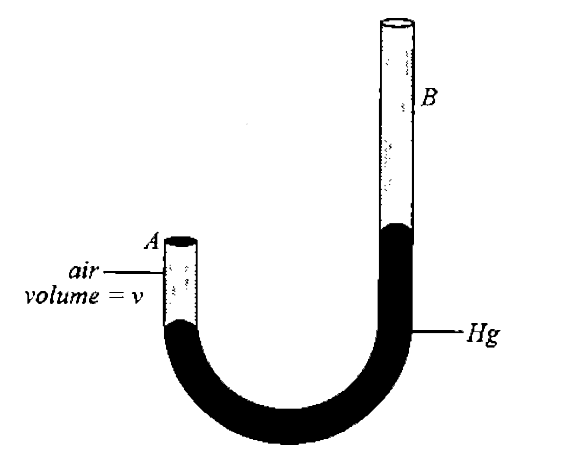 View Solution
View SolutionQuestion 151
A solid ball of density half that of water falls freely under gravity from a height of 19.6 m and then enters water. Upto what depth will the ball go? How much time will take to come again to the water surface? Neglect air resistance and viscosity effects in water (g=9.8m/s2)View SolutionQuestion 157
A tank is filled with water to a height H. A hole is punched in the wall at a depth h below the water surface. Find the distance x from the wall at which the stream strikes the floor. Could a hole be punched at another depth so that this second stream would have the same range? If so at what depth? For what value of h is range maximum?View SolutionQuestion 162
_S01_025_Q01.png)
A cubical block of wood of edge 3 cm floats in water. The lower surface of the cube just touches the free end of a vertical spring fixed at the bottom of the pot. Find the maximum weight that can be put on the block without wetting it. Density of wood =800kg/m3 and spring constant of the spring =50N/m. Take g=10m/s2View SolutionQuestion 164
A container of large uniform cross-sectional area A resting on a horizontal surface, holds two-immiscible, non-viscous & incompressible liquids of densities d & 2d, each of height H/2. The lower density liquid is open to the atmoshpere having pressure P0. A homogeneous solid cylinder of length L(L<H/2) corss-sectional area A/5 is immersed such that it floats with its axis vertical at the liquid interface with the length L/4 in the denser liquid. Determine : (i) The density D of the solid & (ii) The total pressure at the bottom of the container.View SolutionQuestion 167
A level controller is shown in the figure it contains of a thin circular plug of diameter 10 cm and a cyclindrical plug of diameter 20 cm tied together with a light rigid rod of length 10 cm. The plug fits in smoothly in a dram hole at the bottom of the tank which opens into atmosphere. As water fills up and the level reaches height h, the plug opens. Find h. Determine the level of water in the tank when the plug closes again. The float has a mass 3kg and the plug may be assumed as massless.
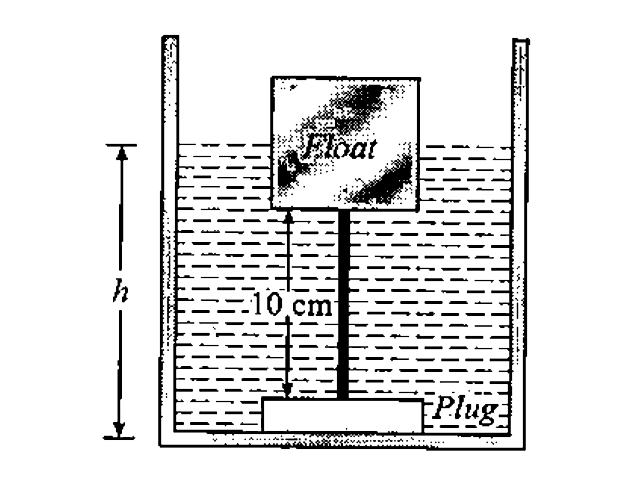 View Solution
View SolutionQuestion 168
Two communicating cylindrical tubes contain mercury. The diametr of one vessel is four times large than the diameter of the outer. A column of water of heigt 70cm is poured into the narrow vessel. How much wil the mercury level rise in the other vessel and how much will it sink in the narow one? How much will the mercury level rise in the narrow vessel, if a column of water of the same height is pured into the broad vessel?
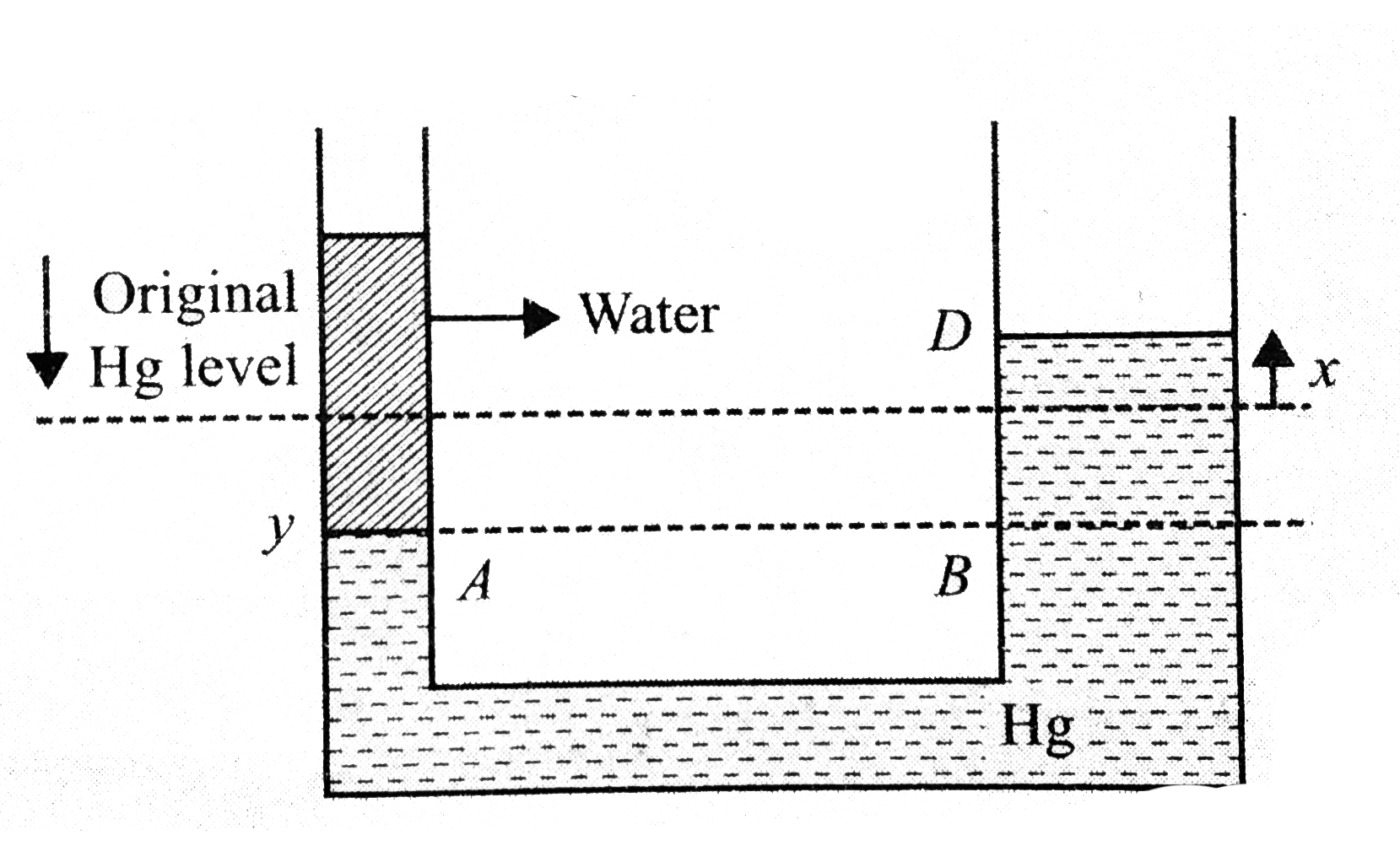 View Solution
View SolutionQuestion 169
The U-tube acts as a water siphon. The bend in the tube is 1m above the water surface. The tube outlet is 7m below the water surface. The water issues from the bottom of the siphon as a free jet at atmospheric pressure. Determine the speed of the free jet and the minimum absolute pressure of the water in the bend. Given atmospheric pressure =1.01×105N/m2,g=9.8m/s2 and density of water =103kg/m3
 .View Solution
.View SolutionQuestion 170
The interface of two liauids of densities ρ and 2ρ respectively lies at the point A in a U tube at rest. The height of liquid columb above A is 8a/3 where AB = a. The cross-sectional area of the tube is S. With what angular velocity the tube must be whirled about a vertical axis at a distance 'a' such that the interface of the liquids shifts towards B by 2a/3.
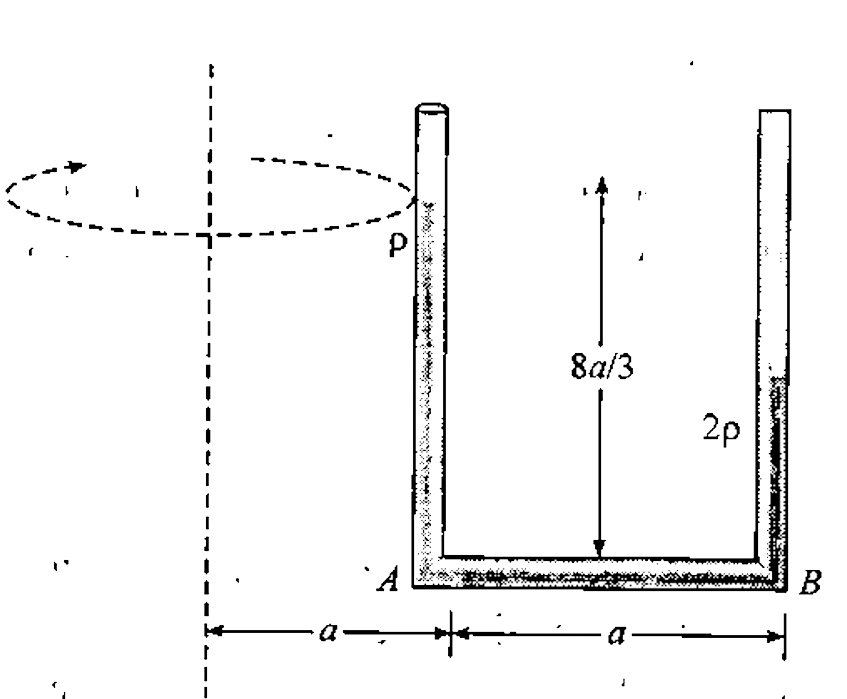 View Solution
View SolutionQuestion 171
A wooden stick of length L, radius R and density ρ has a small metal piece of mass m ( of negligible volume) attached to its one end. Find the minimum value for the mass m (in terms of given parameters) that would make the stick float vertically in equilibrium in a liquid of density σ(>ρ).View SolutionQuestion 172
A container of large uniform cross sectional area A, resting on horizontal surface, holds two immiscible non viscous and incompressible liquids of density d and 2d, each of height H2 as shown in the figure. The lower density liquid is open to the atmosphere having pressure P0. A tiny hole of area (s(s<<A) is punched on the vertical side of the container at a height h(h<H2). Determine
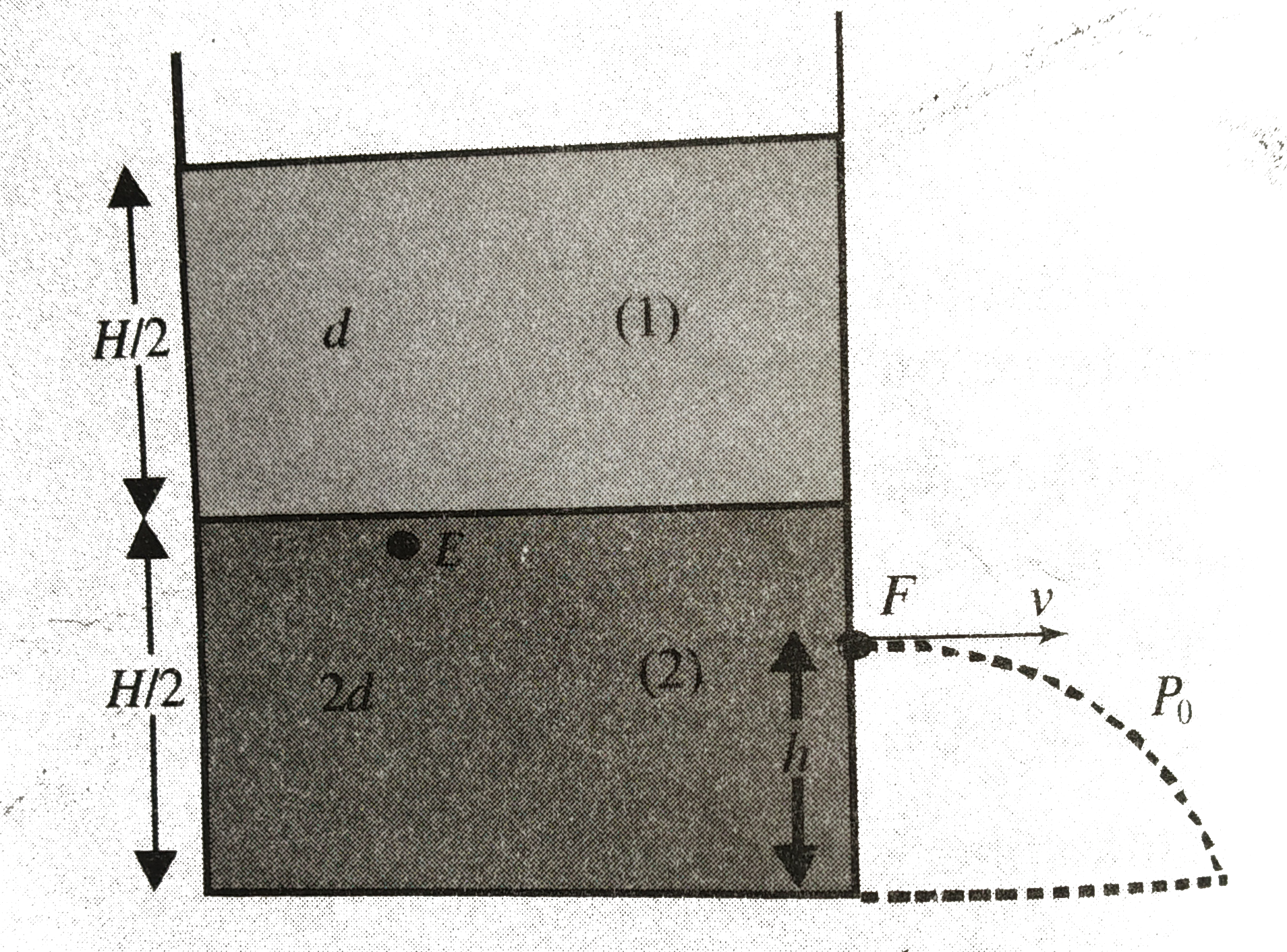
a.the initial speed of efflux of the liquid at the hole
b. the horizontal disance x travelled by the liquid initially
c. the height hm at which at the hole should be punched so that the liquid travels the maximum distance xm initially. also calculate xm (neglect air resistance in calculations).View SolutionQuestion 175
A wooden plank of length 1m and uniform cross-section is hinged at one end of the bottom of tank as shown in figure. The tank is filled with water upto a height of 0.5m. Find the angle θ that the plank makes with the vertical in the equilibrium position. [Exclude the case thea=0]
 View Solution
View SolutionQuestion 176
The cross-sectional area of the U-tube shown in the figure is everywhere uniform and of value 1.25×10−3m2. The horizontal section of the tube is of length 20 cm. When at rest, the limbs of the tube contain a liquid of density 2.5 up to equal heights. If the tube is rotated with angular velocity of 8.4rad/s about one limb, calculate the volume of liquid that flows from one limb to the other.
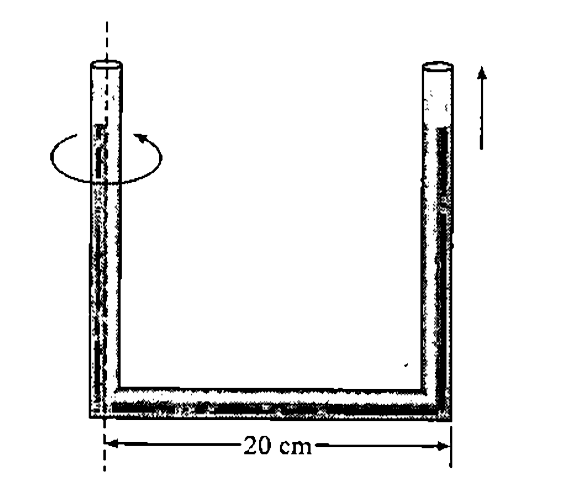 View Solution
View SolutionQuestion 179
A cylindrical tank having cross-sectional area A=0.5m2 is filled with two liquids of density ρ1=900kgm−3 and ρ2=600kgm−3, to a height h=60cm each as shown in the figure. A small hole having area a=5cm2 is made in right vertical wall at a height y=20cm from the bottom. A horizontal force F is applied on the tank to keep it in static equilibrium. The tank is lying on a horizontal surface. Neglect mass of the cylindrical tank in comparison to mass of the liquids (akeg = 10 ms^(-2)).
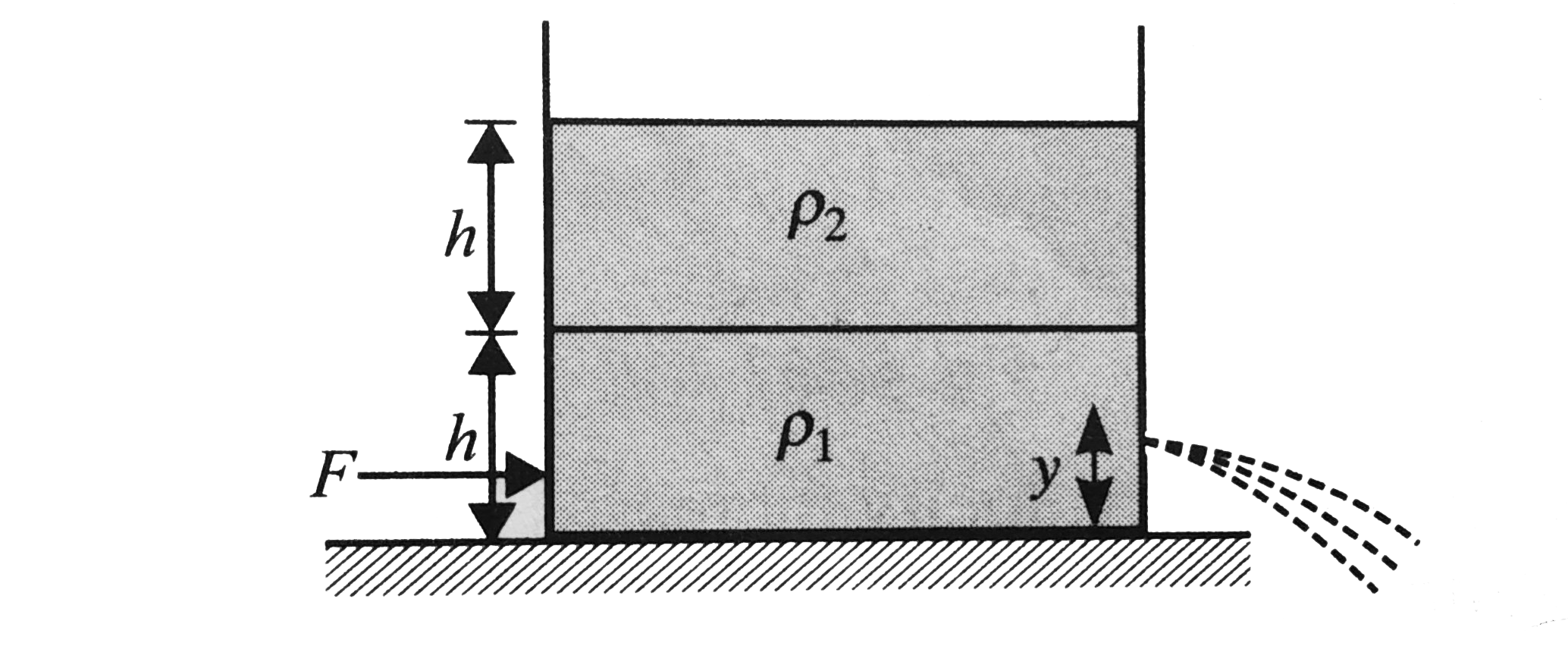
The horizontal force required to keep the cylinder in static equilibrium, on a smooth horizontal plane is View SolutionQuestion 180
A conical vessel wihout a bottom stands on a table. A liquid is poured with the vessel & as soon as the level reaches h, the pressure of the liquid raises the vessel. The radius of the base of the vessel is R and half angle of the cone α and the weight of the vessel is W. What is the density of the liquid ?
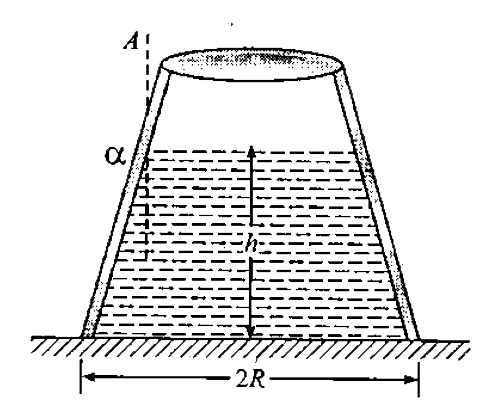 View Solution
View SolutionQuestion 185
A water clock used in ancient Greek is designed as a closed vessel with a small orifice O. The time is determined accrding to the level of the water in the vessel. What should be the shape of the vessel be for the time scale to be uniform. Find mathemtical equation governing curve AOB.
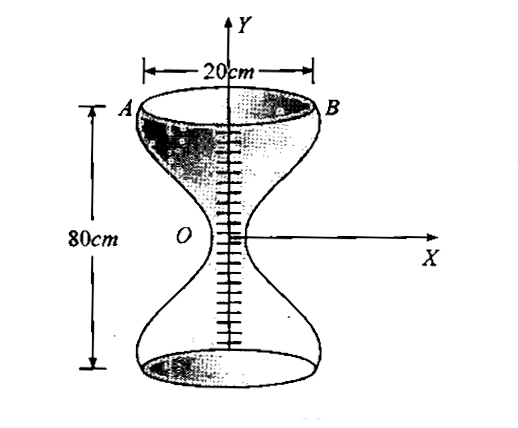 View Solution
View SolutionQuestion 187
Two identical container are open at the top and are connected at the bottom via a tube of negligible volume and a valve which is closed. Bith containers are filled initially to the same height 1.00m, one with water the other with mercury, as the drawing indicates. The valve is then opened. Water and mercury are immiscible. Determine the fluid level in the left container when equilibrium is re-established.
 View Solution
View SolutionQuestion 188
A thin rod of length (L) and area of cross - section (S) is pivoted at its lowest point (P) inside a stationary, homegeneous and non - viscous liquid. The rod is free to ratate in a vertical plane about a horizontal axis passing through (P). The density (d_1) of the material of the rod is smaller than the density (d_2) of the liquid. The rod is displaced by a small angle (theta) from its equilibrium position and then released. Show that the motion of the rod is simple harmonic and determine its angular frequency in terms of the given parameters.
 .View Solution
.View SolutionQuestion 189
Consider a horizontally oriented syringe containing water locate at a height of 1.25m above the ground. The diameter of the plunger is 8mm and the diameter of the nozzle is 2mm. The plunger is pushed with a constant speed of 0.25m/s. Find the horizontal range of water stream on the grond. Take g=10m/s2
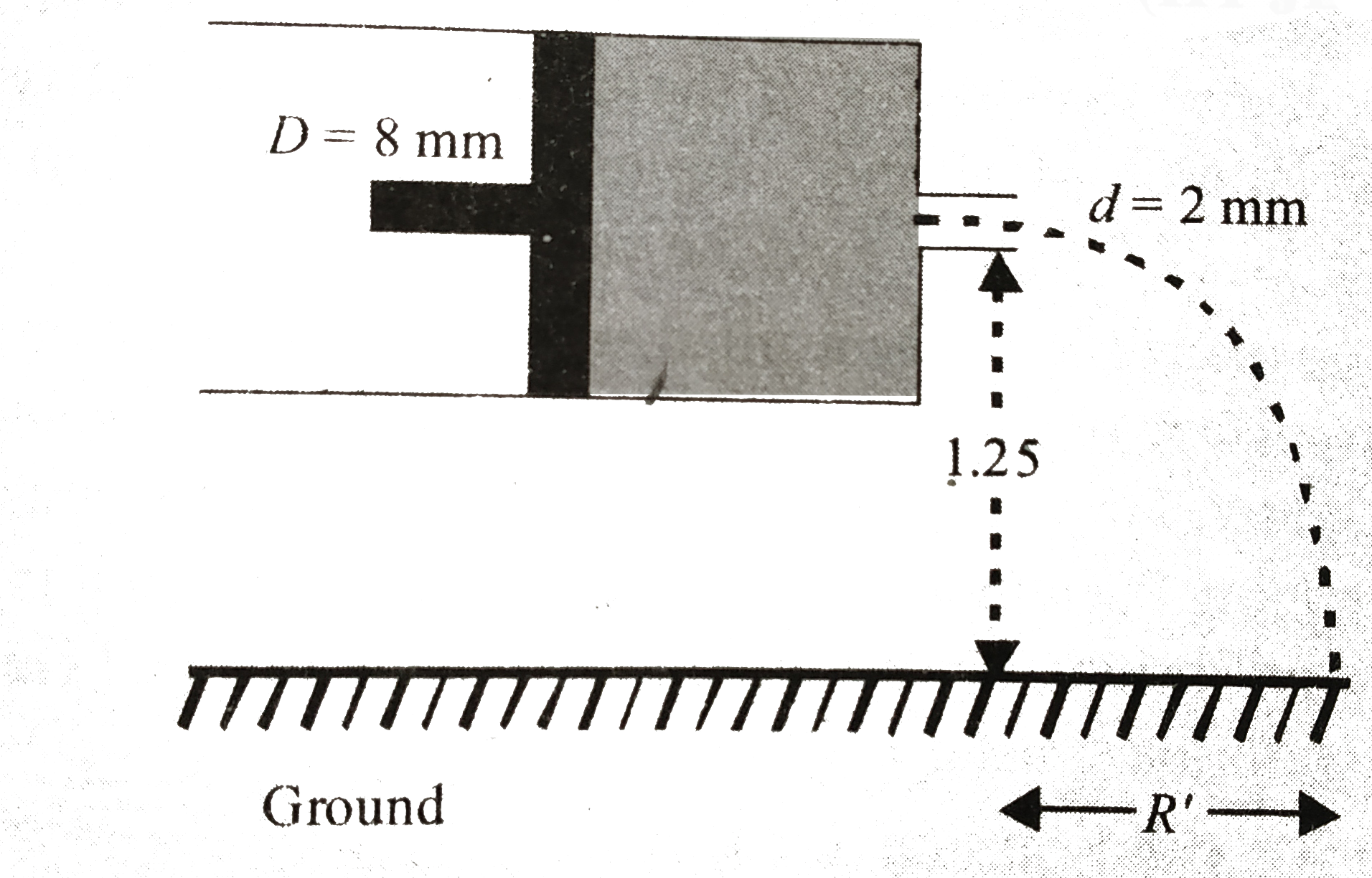 View Solution
View SolutionQuestion 190
A water pipe with interna diameter of 2m carries water at the floor of a house with velocity 2 m/s and at pressure 2×105N/m2. Another pipe of internal diameter 1 cm is connected to it and takes water to 1 st floor, 5m above ground. What is the velocity and water pressure at 1st floor ? (Take g=10m/s2).View SolutionQuestion 193
Water flows out of a big tank along a tube bent at right angles, the inside of the tube is of radius r. The length of the horizontal portion is l. The rate of water flow is Q. Find the moment of reaction forces of flowing water, acting on the tube walls relative to point O.
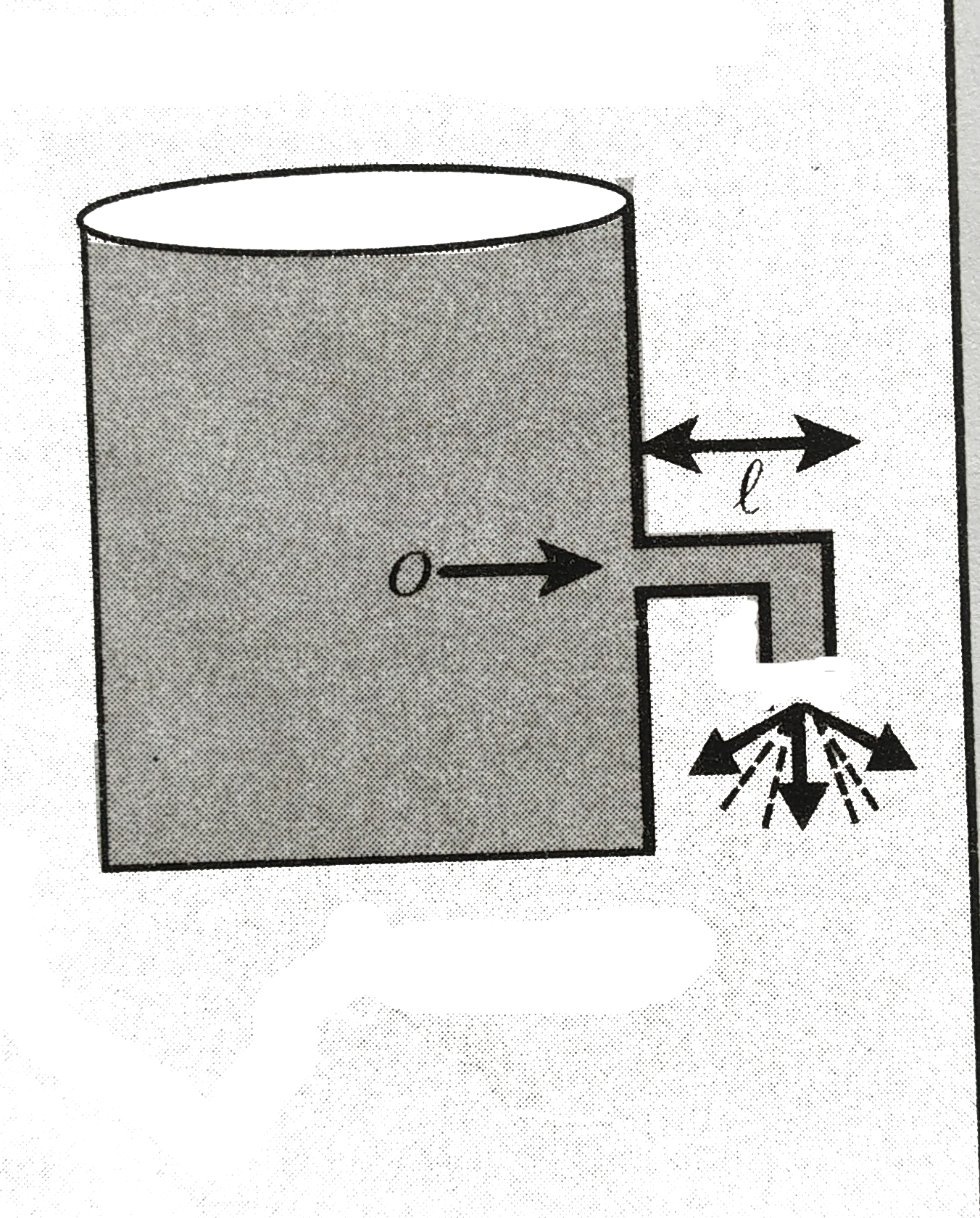 View Solution
View SolutionQuestion 194
A cylindrical vessel is filled with water upto a height of 1m. The cross-sectional area of the orifice at the bottom is (1/400) that of the vessel.
(a) What is the tiome required to empty the tank through the orifice at the bottom?
(b) What is the time required for the same amount of water to flow out if the water level in tank is maintained always at a height of 1m from orifice?View SolutionQuestion 195
An open reactangular tank with tank with dimensions 5×4m×3m contains water upto a height of 2m is accelerated horizontally along the longer life.
(a) Determine the maximum acceleration that can be given without spilling the water.
(b) If this acceleration is inscreased by 20%. Calculate the percentage of water spilt over.
(c) If initially,the tank is closed at the top and is accelerated horizontally by 9m/s2,find the gauge pressure at the bottom of the front and rear walls of the tank. (g=10m/s2)
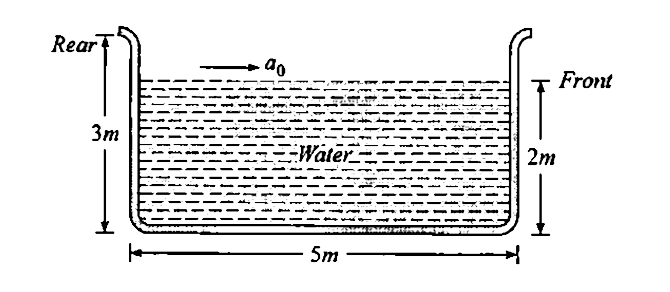 View Solution
View SolutionQuestion 196
Two holes, each of area A=0.2cm2 are drilled in the wall of a vessel filled with water. The distances of the holes from the level of water are h and h+H. Find the point where the streams flowing out of the holes intersect. The level of water is maintained in the vessel by regulated supply.
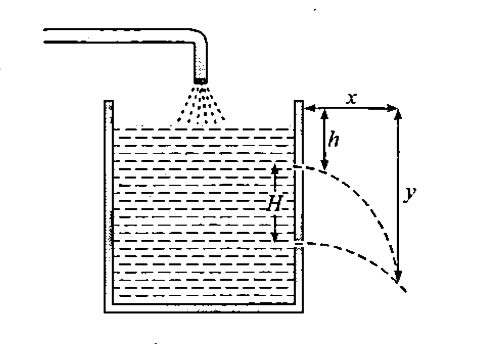 View Solution
View SolutionQuestion 197
A vertical tube has diameter 0.016 m at its bottom end from which water flows out at the rate of 1.2 kg per minute. The pressure at the end is atmospheric pressure 0.7 m of mercury. If the diameter of the tube is 0.004 m at a height of 0.3 m from the bottom end, fidn the pressure there.View SolutionQuestion 199
A large open top container of negligible mass and uniform cross sectional area A a has a small hole of cross sectional area A/100 in its side wall near the bottom. The container is kept on a smooth horizontal floor and contains a liquid of density ρ and mass M0. Assuming that the liquid starts flowing out horizontally through the hole at t=0, calculate a the acceleration of the container and b its velocity when 75% of the liquid has drained out. View SolutionQuestion 200
A cylindrical bucket, open at the top, is 0.200 m high and 0.100 m in diameter. A circular hole wih cross-section area 1.00cm2 is cut in the centre of the bottom of the bucket. Water flows into the bucket from a tube above it at the rate of 1.30×10−4m3/s. How high will the water in the bucket rise?View SolutionQuestion 201
A uniform cylindrical block of length l density d1 and area of cross section A floats in a liquid of density d2 contained in a vessel (d2>d1). The bottom of the cylinder just rests on a spring of contant k. The other end of the spring is fixed to the bottom of the vessel. A weight that may be placed on top of the cylinder such that the cylinder is just submerged in the liquid. find the weight.
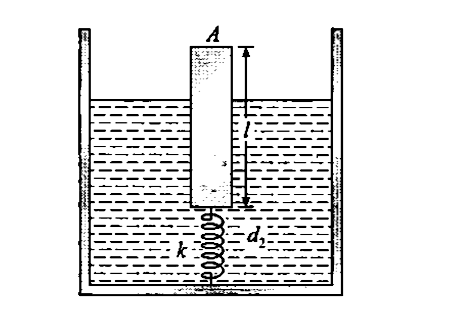 View Solution
View SolutionQuestion 202
A ball of density d is dropped on to a horizontal solid surface. It bounces elastically from the surface and returns to its original position in a time t1. Next, the ball is released and it falls through the same height before striking the surface of a liquid of density of dL
(a) If d<dL, obtain an expression (in terms of d, t1 and dL) for the time t2 the ball takes to come back to the position from which it was released.
(b) Is the motion of the ball simple harmonic?
(c) If d=dL, how does the speed of the ball depend on its depth inside the liquid? Neglect all frictional and other dissipative forces. Assume the depth of the liquid to be large.View SolutionQuestion 203
A side wall of a wide open tank is provided with a narrowing tube through which water flows out. The cross-sectional area of the tube decreases from S=3.0cm2 to s=1.0cm2. The water level in the tank is h=4.6m heigher than in the tube. Neglecting the viscosity of water, find the horizontal component of the force tending to pull the tube out of the tank.
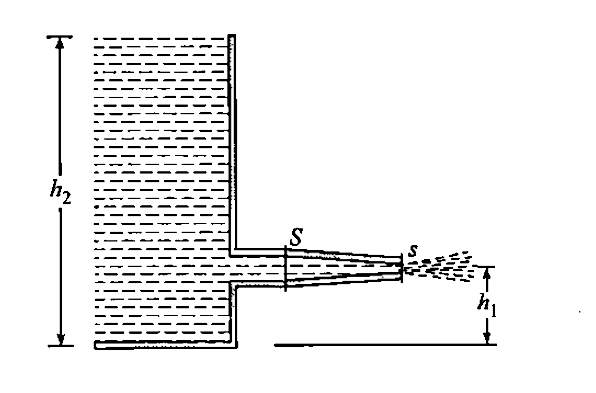 View Solution
View SolutionQuestion 205
Water leaks out from an open tank through a hole of area 2mm2 in the bottom. Suppose water is filled up to a height of 80 cm and the area of cross section of the tankis 0.4m2. The pressure at the open surface and the hole are equal to the atmospheric pressure. Neglect the small velocity of the water near the open surface in the tank. a. Find the initial speed of water coming out of the hole. b. Findteh speed of water coming out when half of water has leaked out. c. Find the volume of water leaked out during a time interval dt after the height remained is h. Thus find the decrease in height dh in term of h and dt.
d. From the result of part c. find the time required for half of the water to leak out.View SolutionQuestion 206
A steel ball floats in a vessel with mercury. How will be volume of the part of the ball submerged in mercury change if a layer of water completely covering the ball is poured above the mercury? If ρw,ρs and ρm are the densities of water, steel and mercury, find the ratio of these two volumes in terms in of ρw,ρs and ρm.View Solution
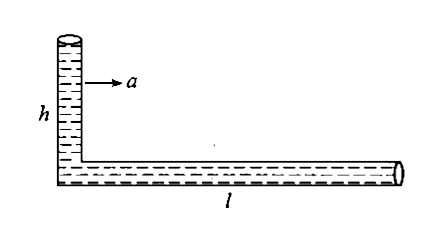
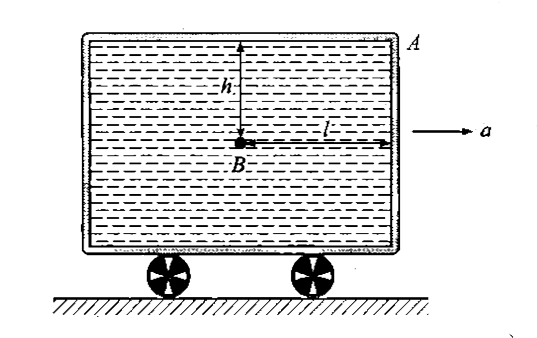
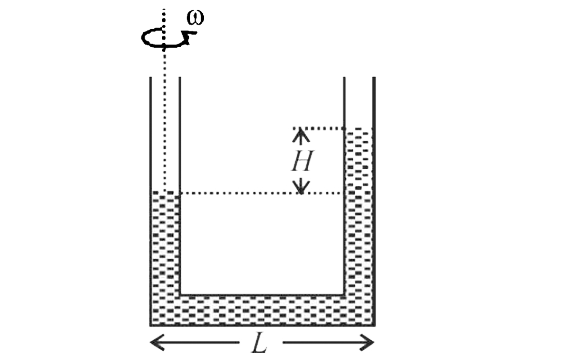

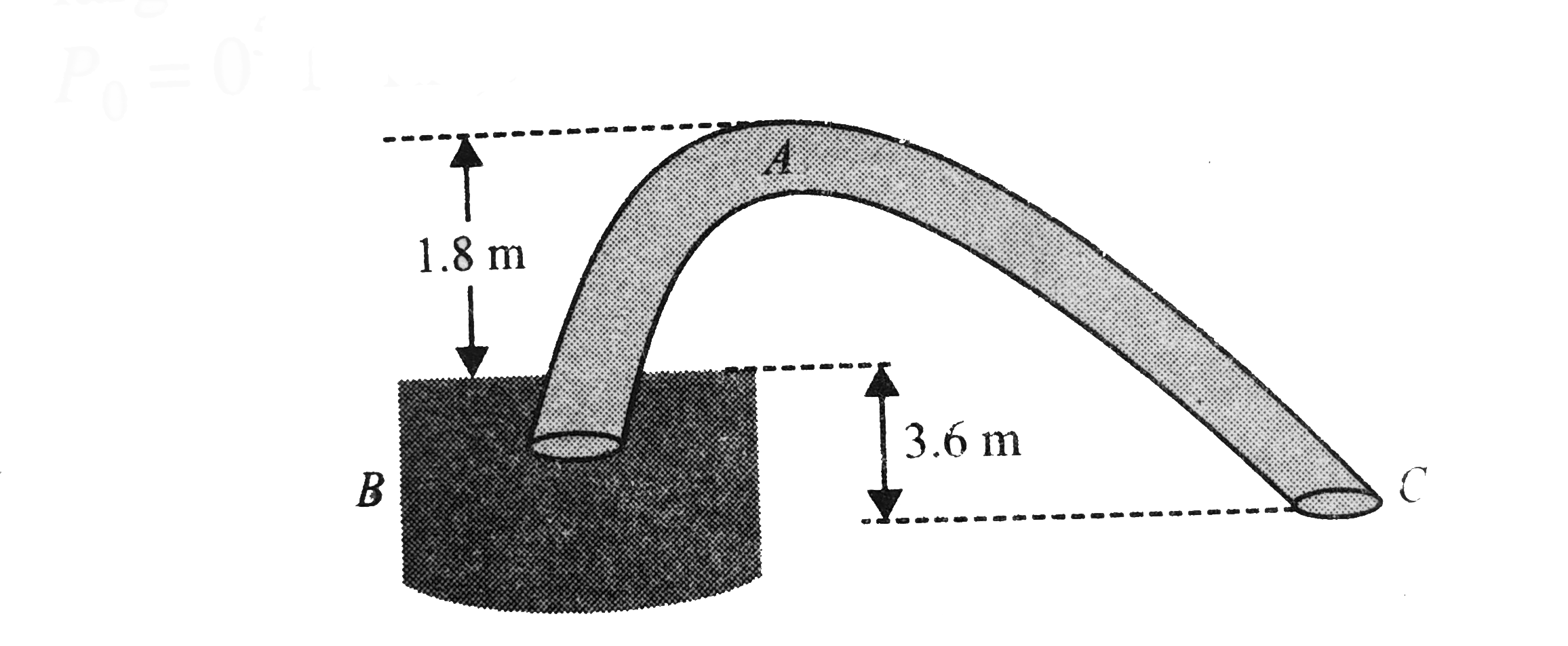

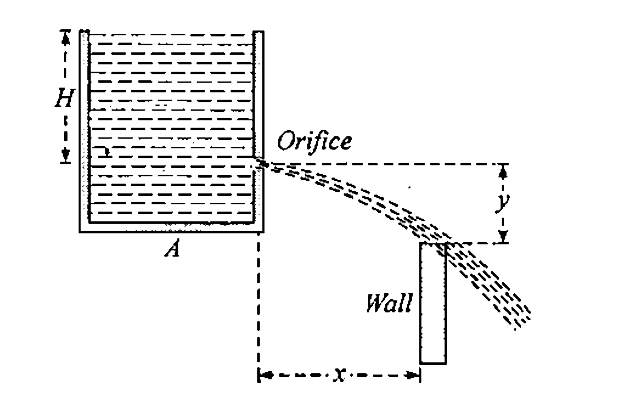
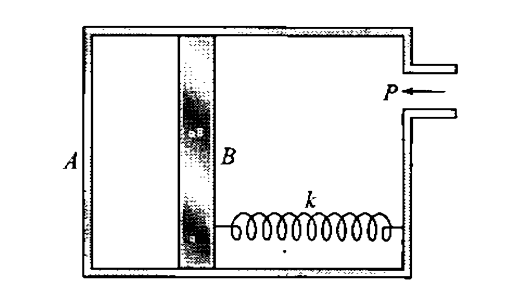
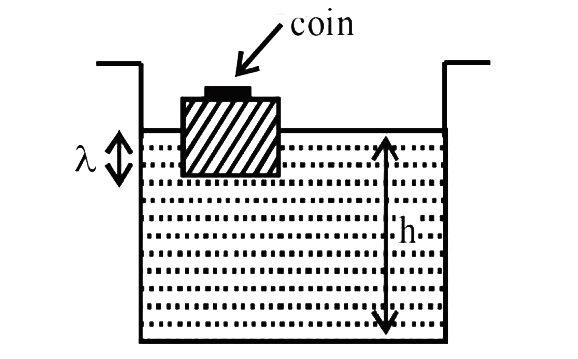
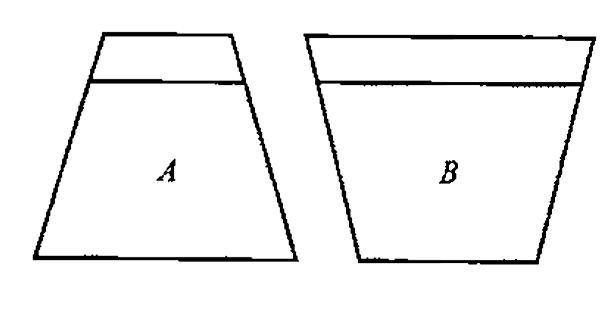
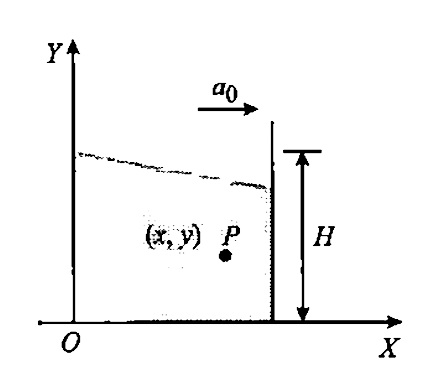
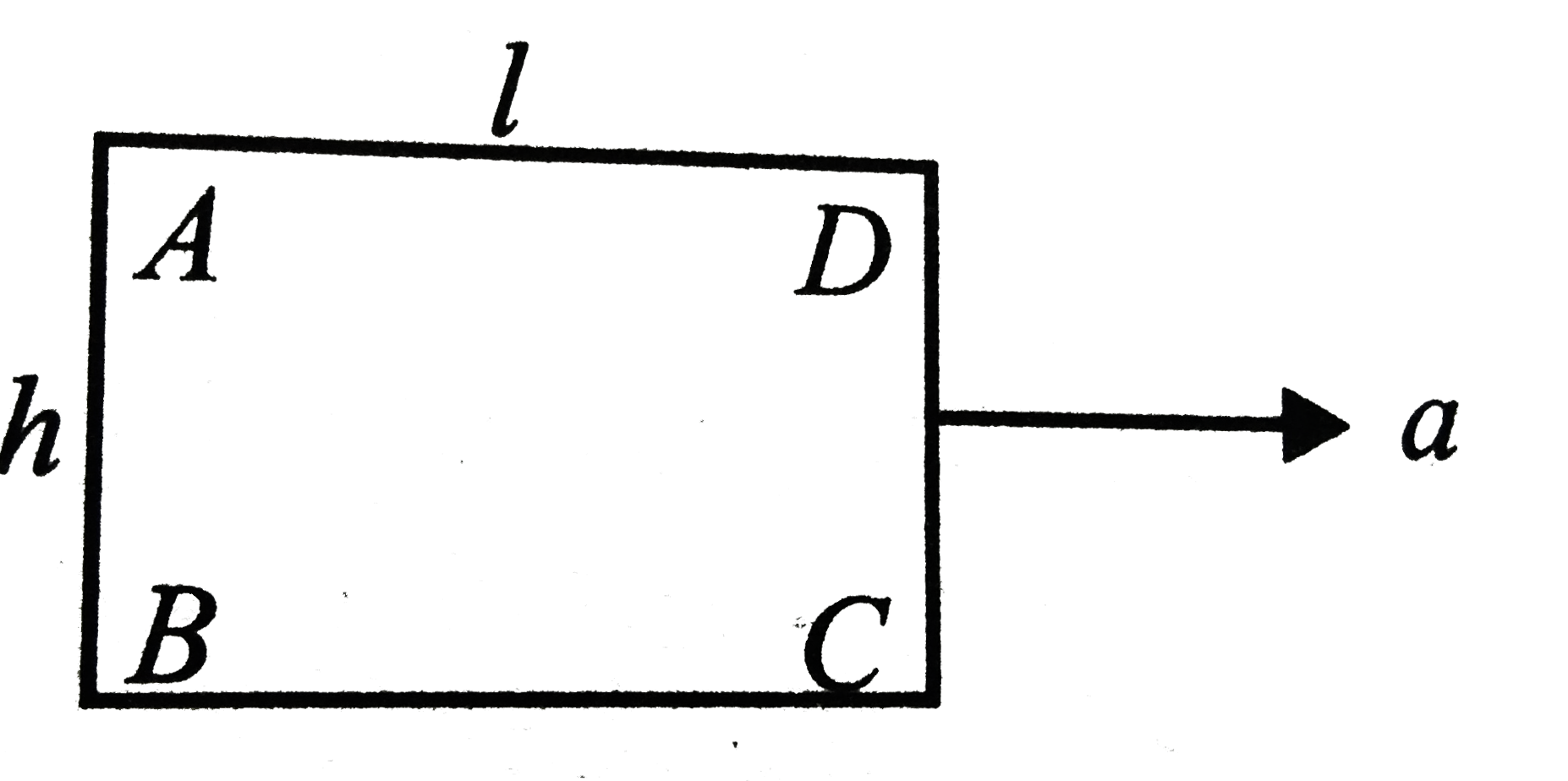
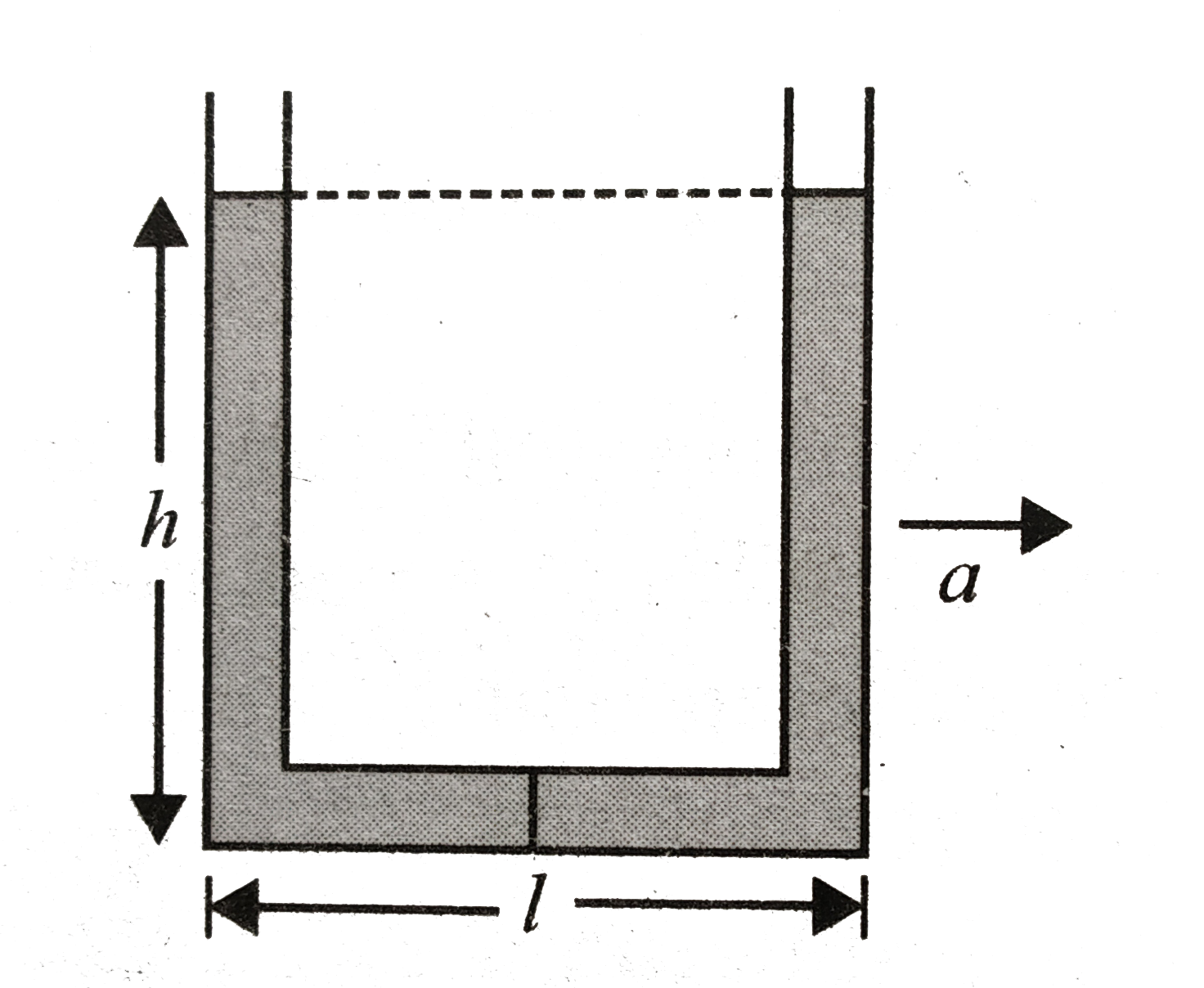
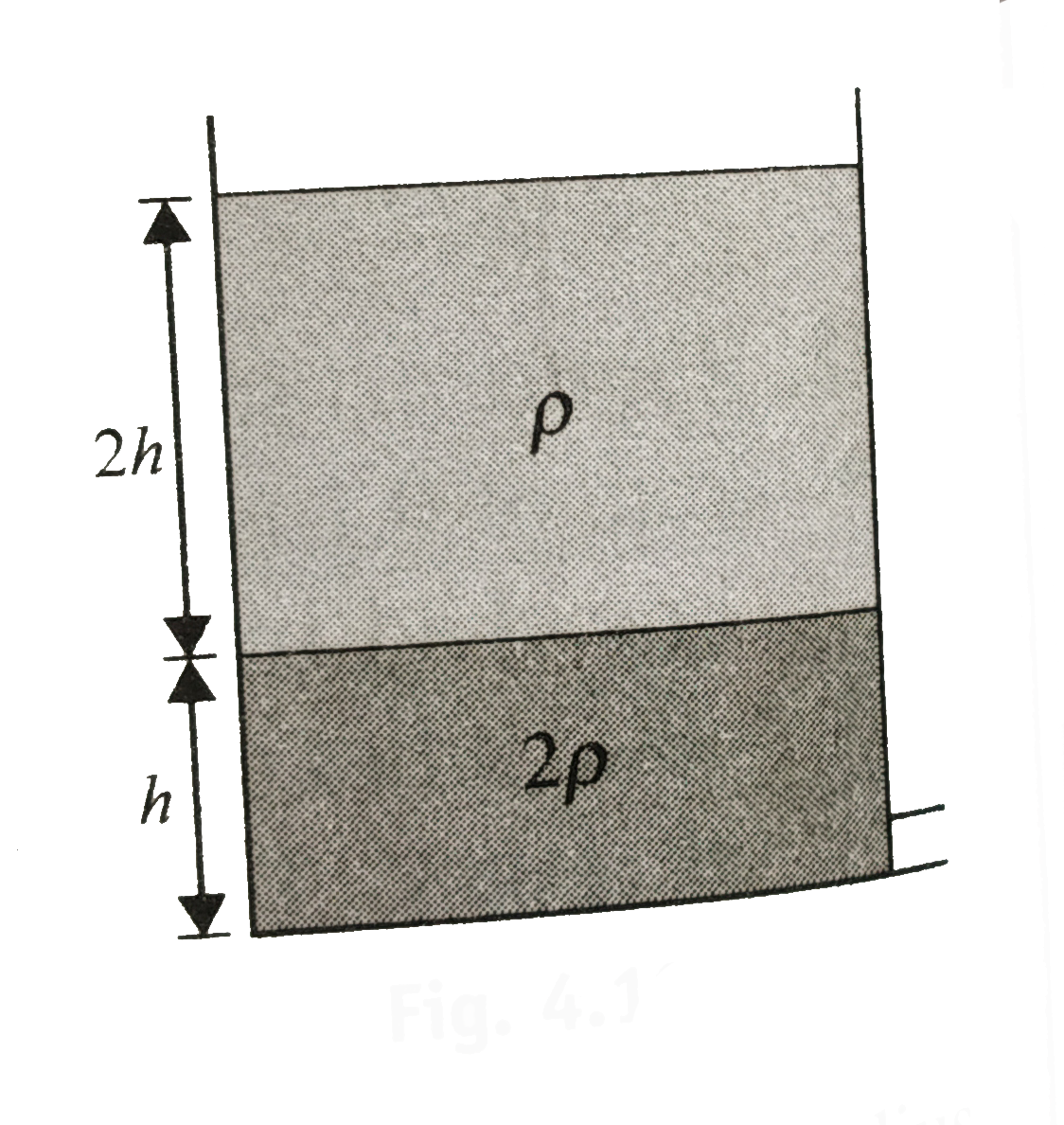
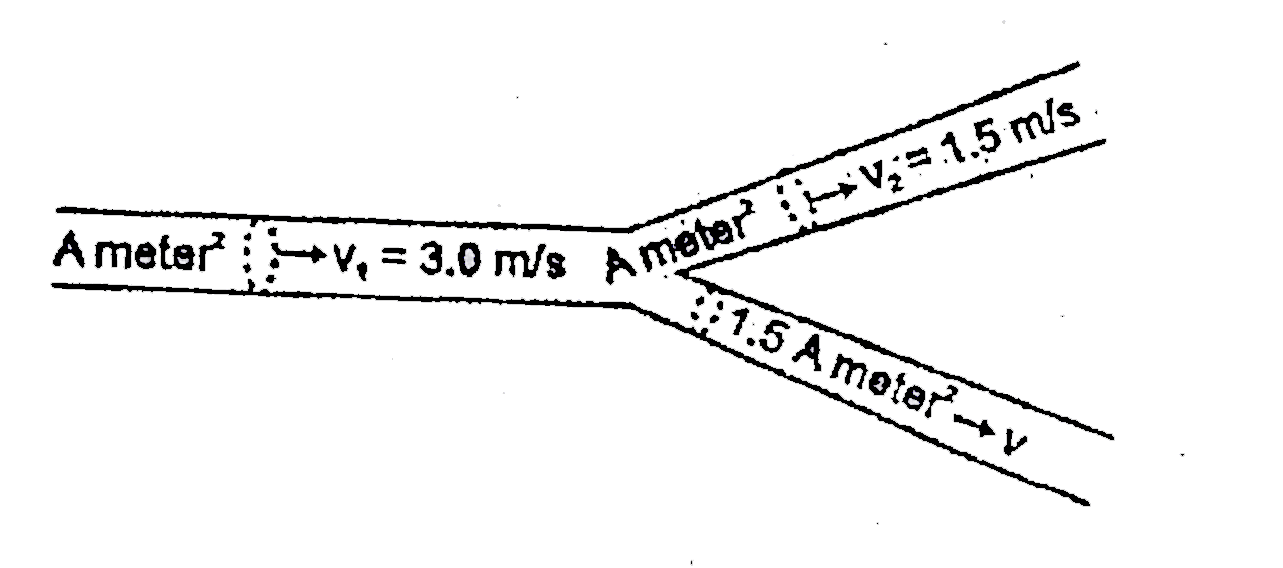
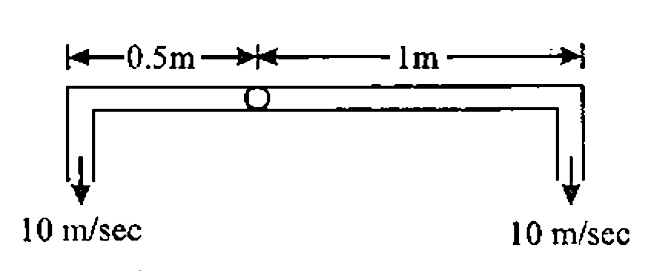
_S01_019_Q01.png)

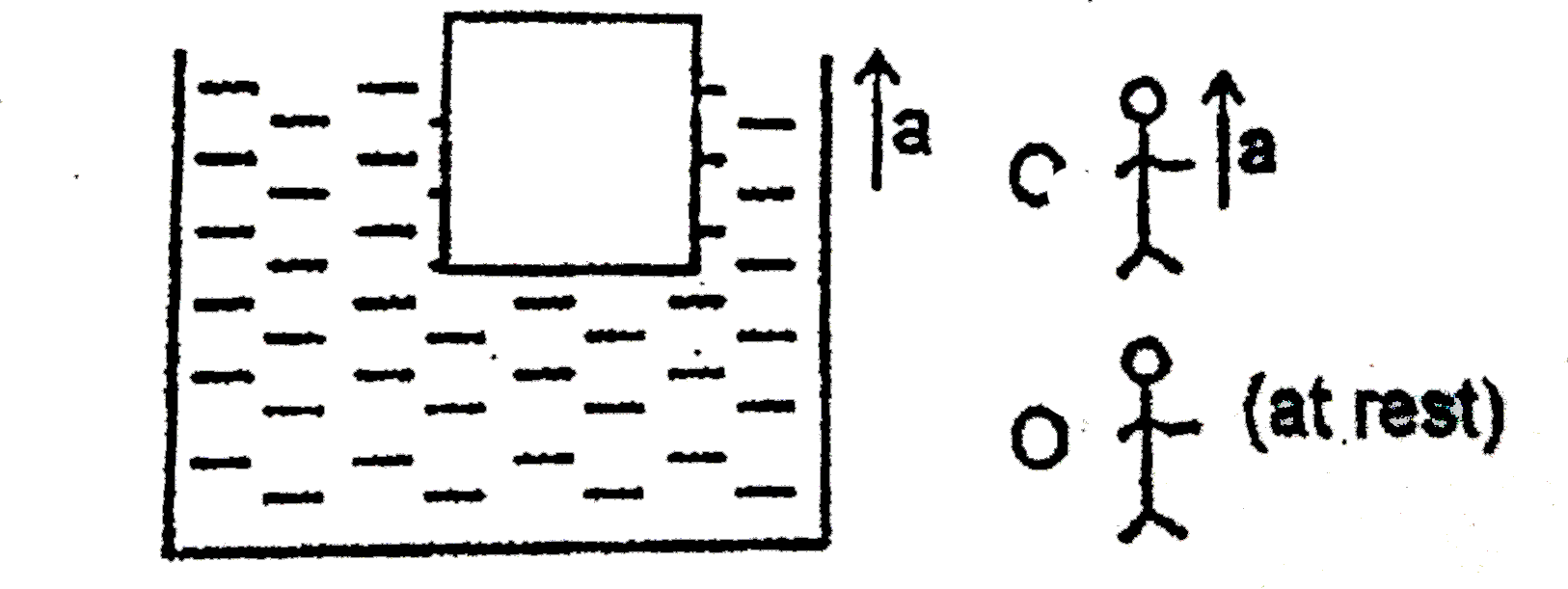
 ,
,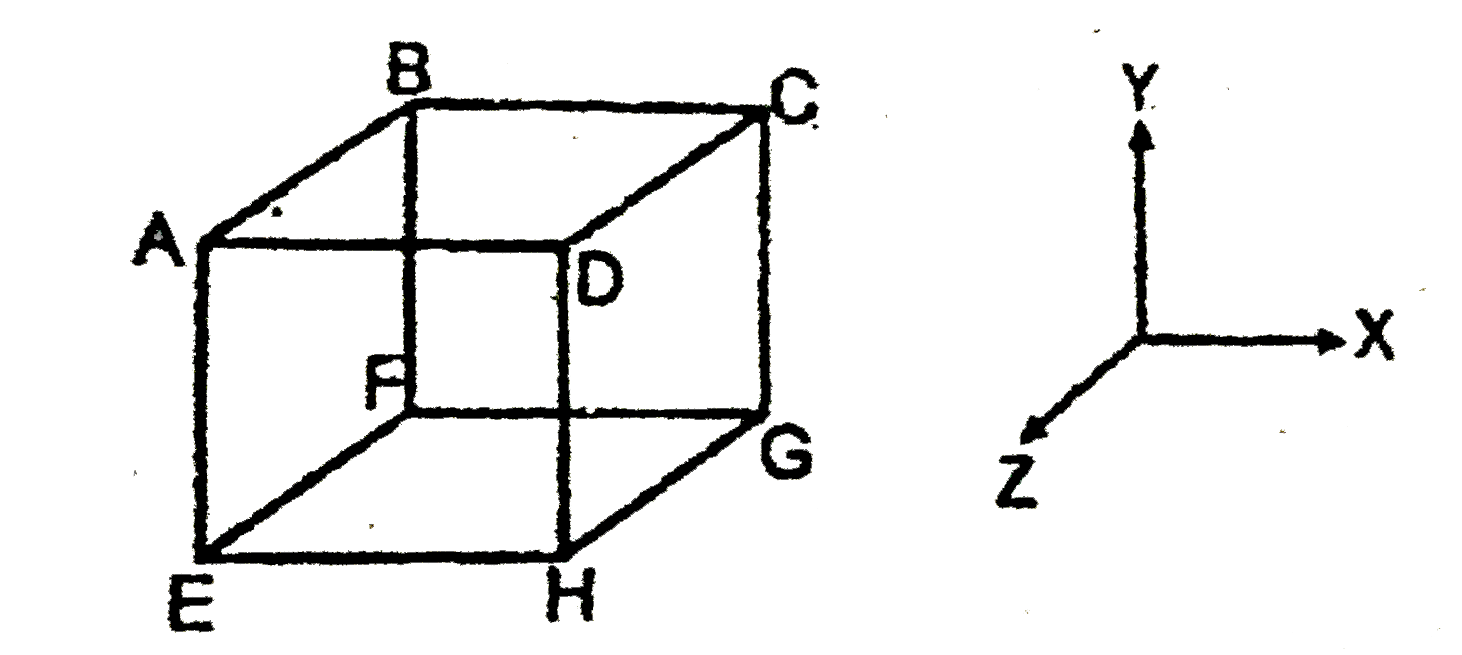
_S01_083_Q01.png)
_S01_020_Q01.png)
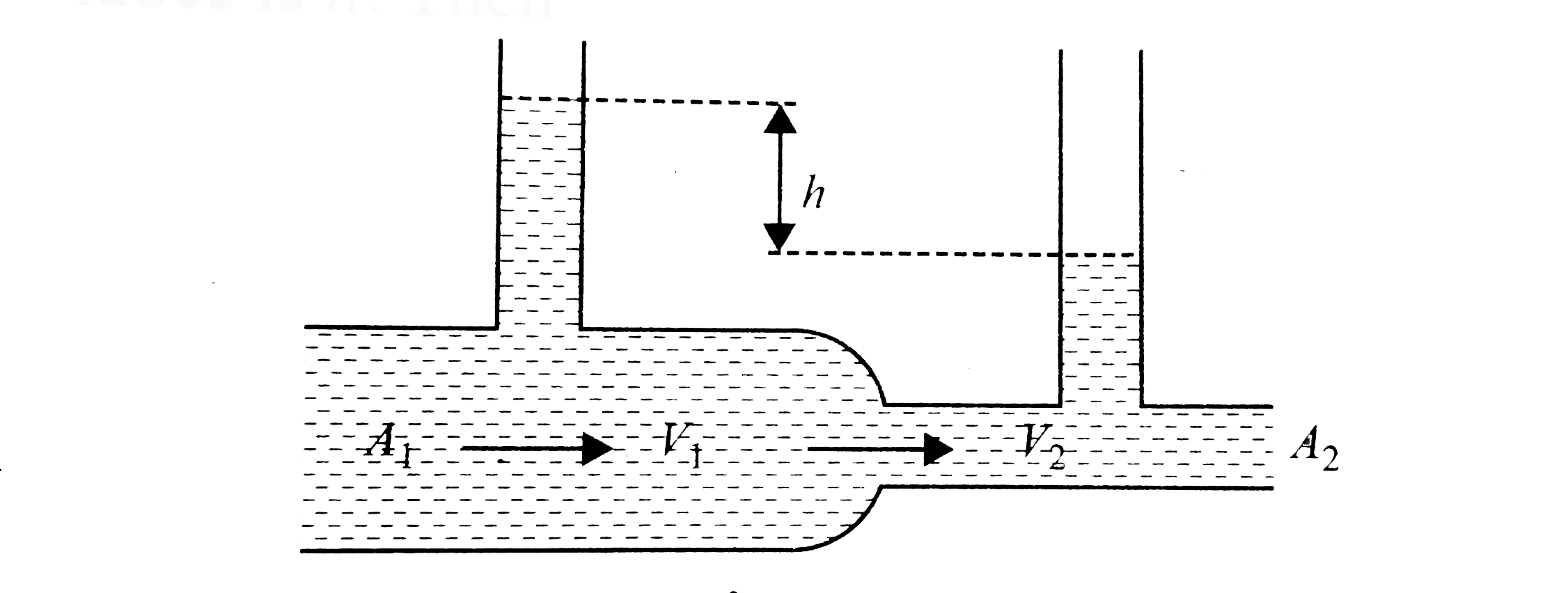
_E01_126_Q01.png)
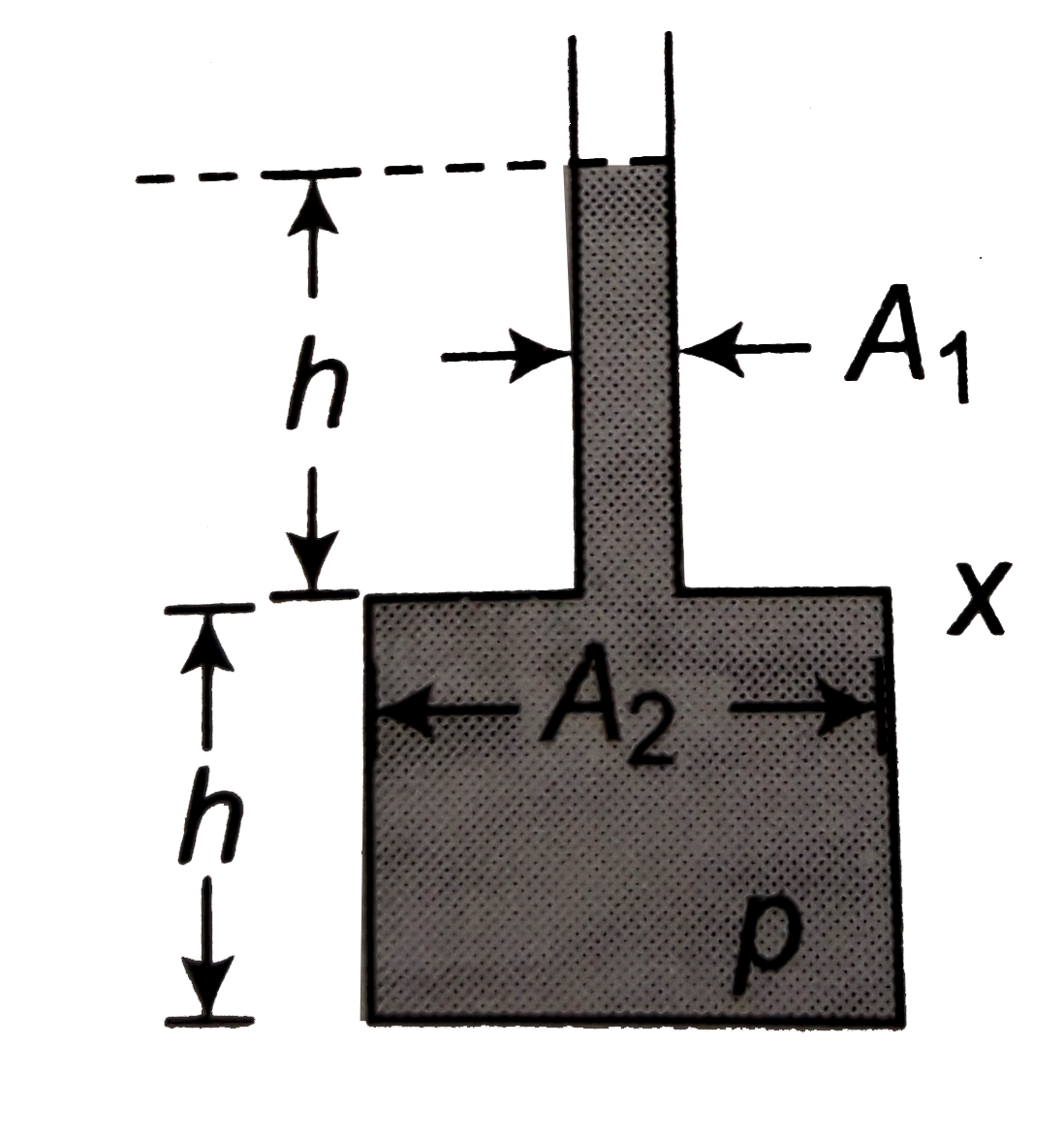 .
.

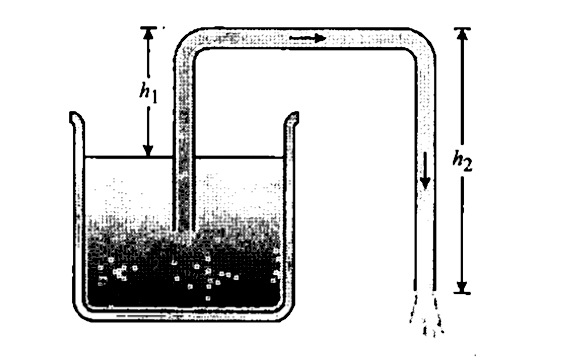

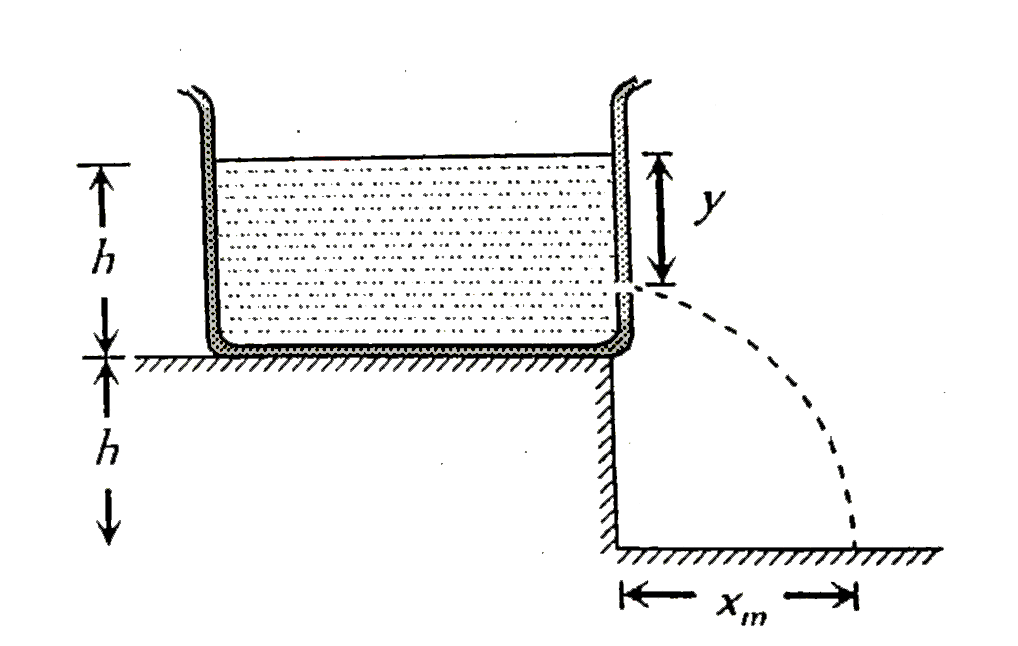
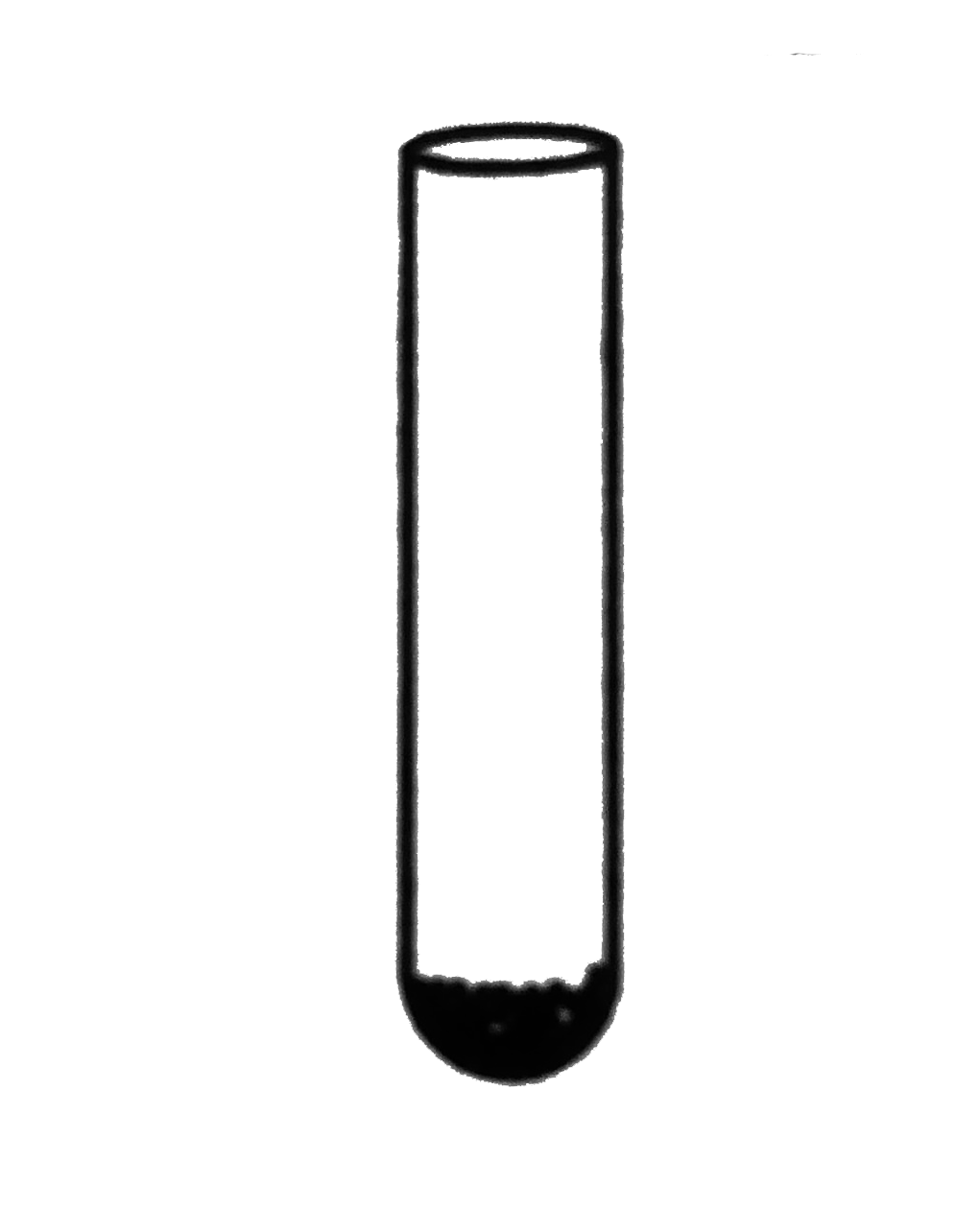

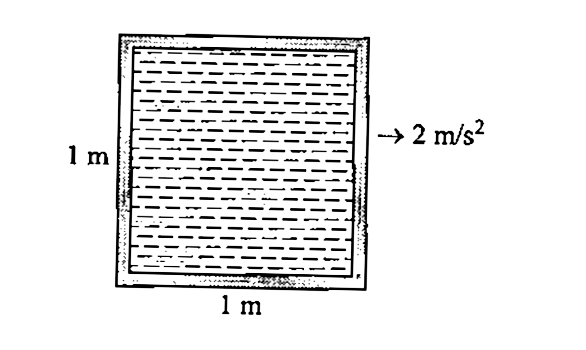
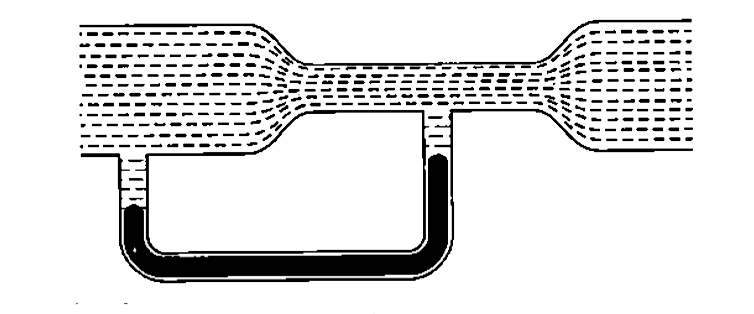
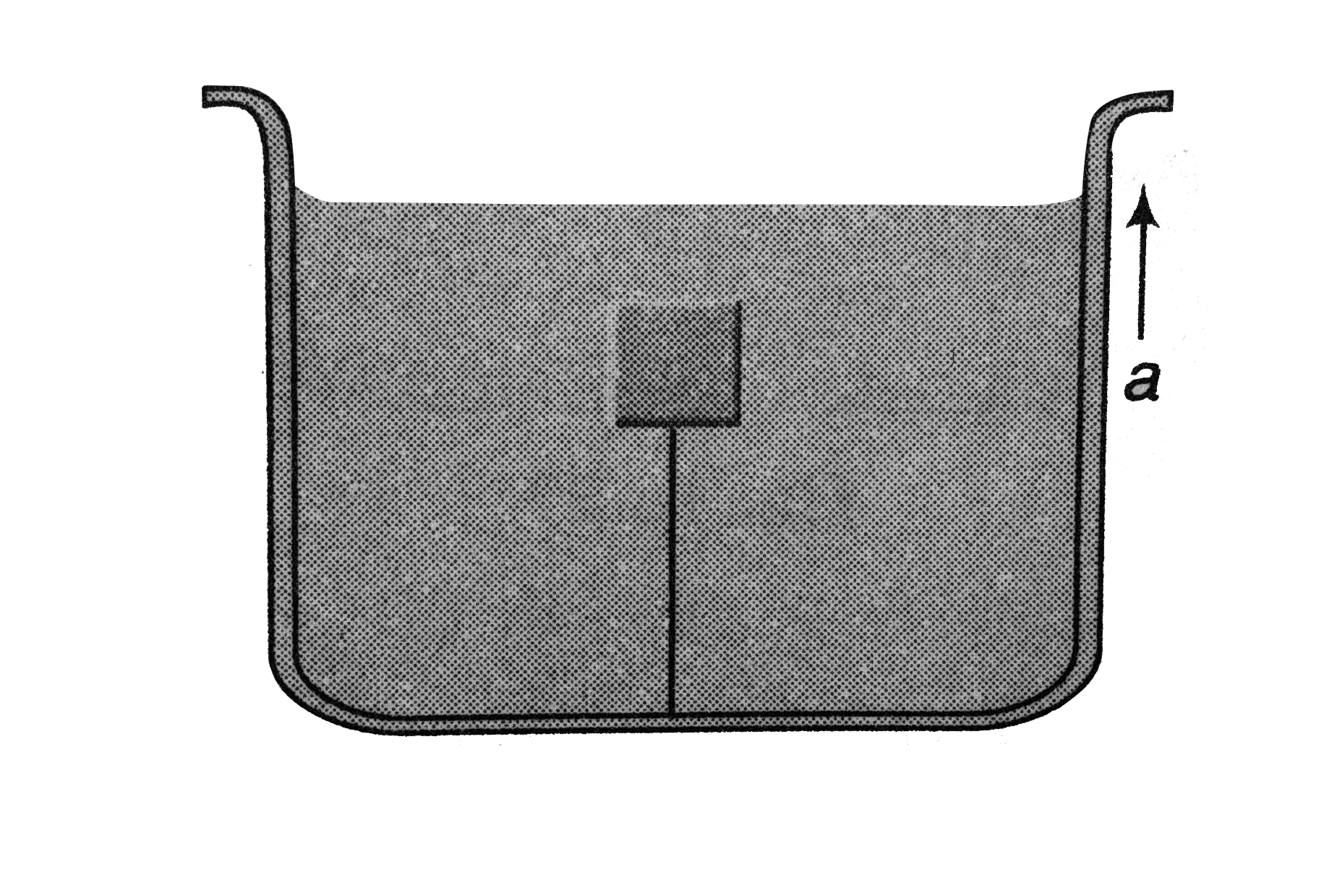 .
.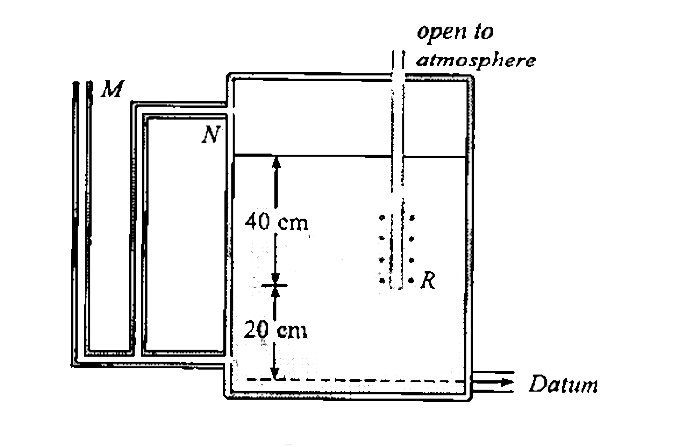

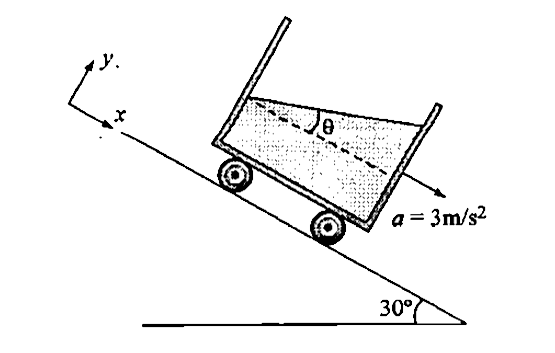
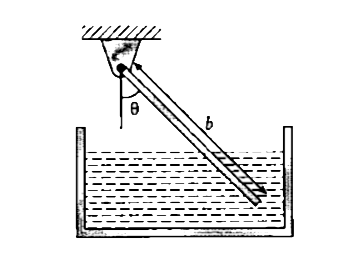
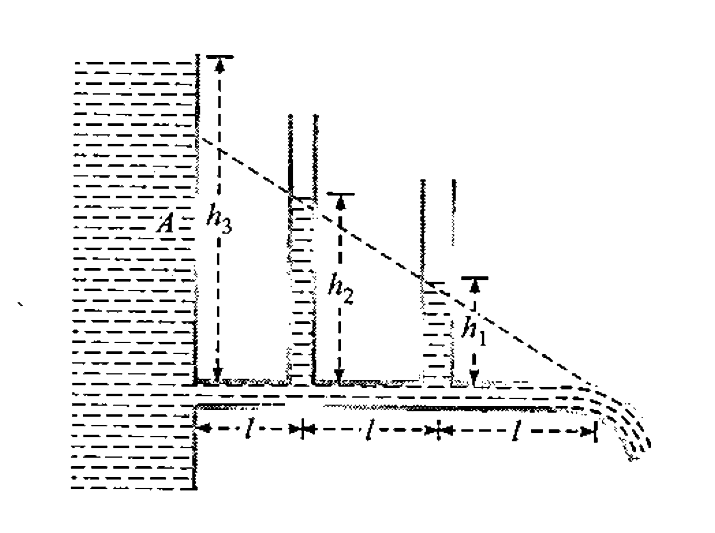
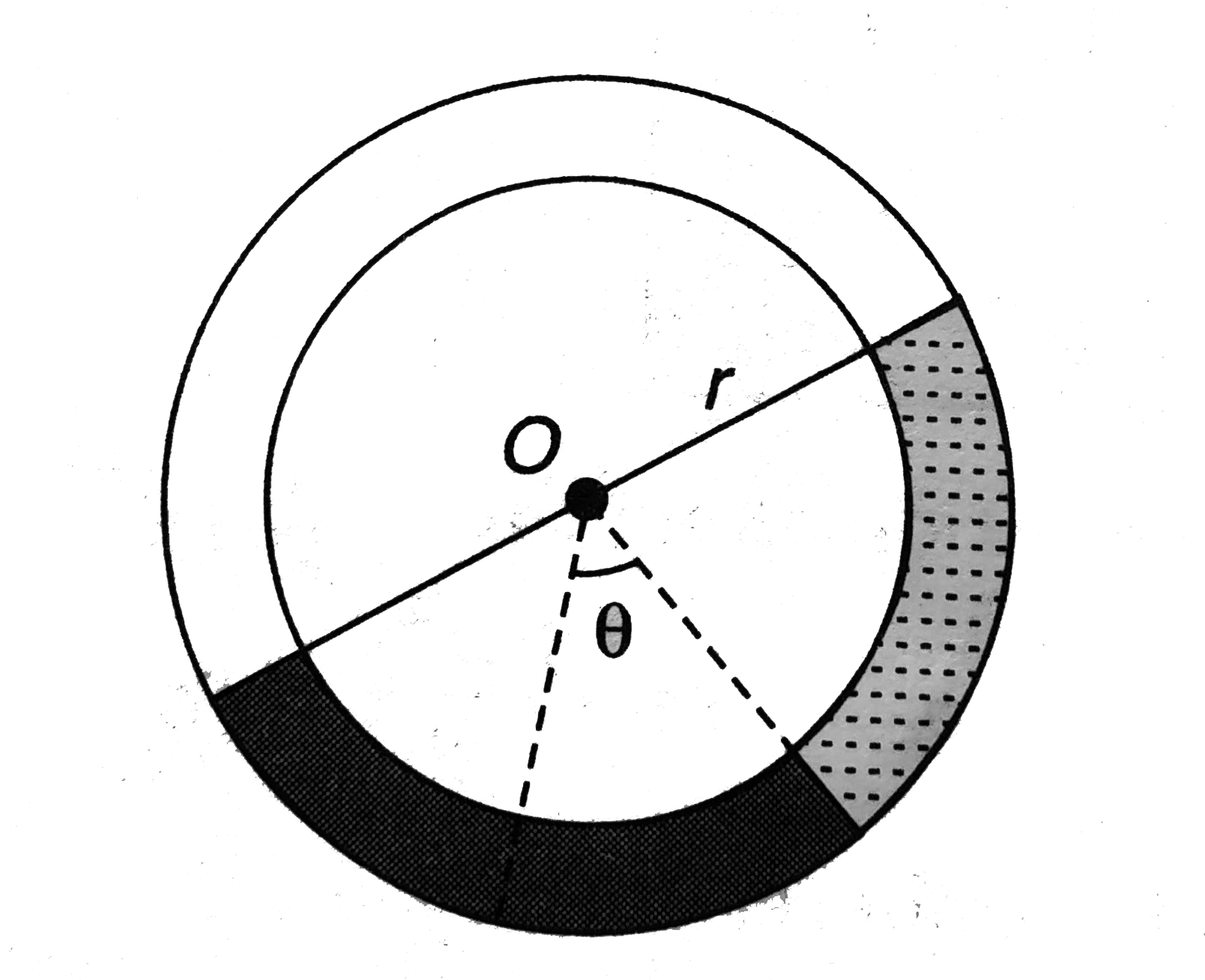
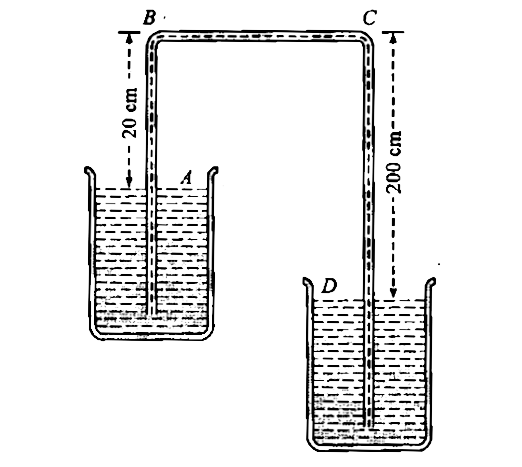
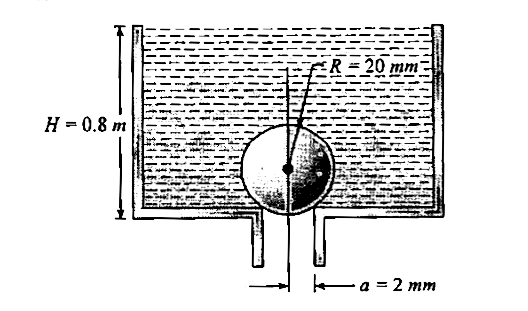
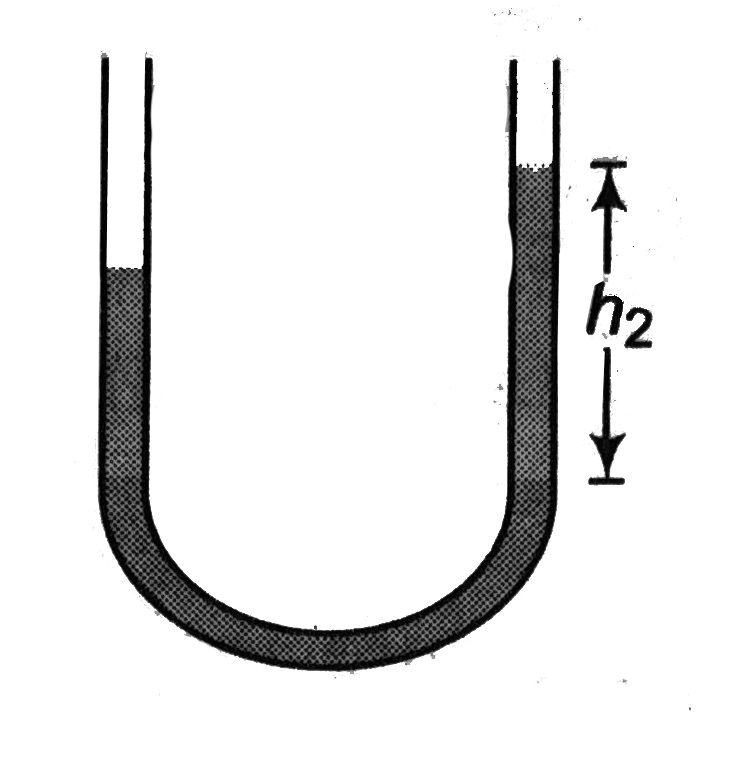 .
.